








HIGHER ED DIRECTORY: A LOOK AT THE STATE’S LEARNING INDUSTRY LENDINGTREE CLIMBS BACK | MAKING SENSE OF MAKERSPACES | JOHNSTON’S PHARMA PROWESS Price: $3.95 businessnc.com MAY 2023



4 UP FRONT
6 POINT TAKEN
Public-private cooperation pays for pharma giants in Johnston County.
10 POWER LIST INTERVIEW
Lawyer Mike Fox juggles key roles in development, transportation posts
12 ENERGIZERS
An Air Force pilot and Kinston dentist build a conglomerate of businesses that reflect their passions.
16 NC TREND
How the Liquid Pleasure band keeps grooving; Brewer bets on canned cocktails; Methodist University plans to produce physicians in Fayetteville; First Citizens Bank shows perfect timing; Top N.C. execs press plan to boost state’s R&D investment.
72 GREEN SHOOTS



A $50 million program aims to propel overlooked N.C. businesses.
28 ROUND TABLE: BIOTECHNOLOGY





Biotech companies discuss plans to attract students and workers to their fast-growing industry.


38 NC PROFILES: BUSINESSES SUPPORTING VETERANS
Organizations across the state are focused on supporting and hiring veterans.
64 COMMUNITY CLOSE UP: UNION COUNTY



Manufacturing and aerospace add to growth in a county that also hosts a thriving agricultural sector.
COVER STORY
HIGHER EDUCATION
Our annual guide to the state’s public and private colleges and universities, from enrollment, to cost, to graduation rates.



 BY EBONY MORMAN
BY EBONY MORMAN
PRUNING TIME
Fintech innovator LendingTree recharges after some larger rivals stole its thunder.
 BY MIKE MACMILLAN
BY MIKE MACMILLAN

DO IT YOURSELF
Makerspaces give Tar Heel entrepreneurs, do-it-yourself enthusiasts, and artists the tools and space to grow.

 BY SHANNON CUTHRELL
BY SHANNON CUTHRELL
3 MAY 2023 May 2023, Vol. 43, No. 5 (ISSN 0279-4276). Business North Carolina is published monthly by Business North Carolina at 1230 West Morehead Street, Suite 308, Charlotte, NC 28208. Phone: 704-523-6987. All contents copyright © by Old North State Magazines LLC. Subscription rate: 1 year, $30. For change of address, send mailing label and allow six to eight weeks. Periodicals postage paid at Charlotte, NC, and additional offices. POSTMASTER: Send address changes to Business North Carolina, 1230 West Morehead Street, Suite 308, Charlotte, NC 28208 or email circulation@businessnc.com. Start your day with business news from across the state, direct to your inbox. SIGN UP AT BUSINESSNC.COM/DAILY-DIGEST.
MAY 2023
42
56 60
David Mildenberg
W
Seriously, the settlement of a muchpublicized defamation lawsuit in mid-April raised important issues on how the media operates in 2023. My sense is that most readers don’t care about the inner workings of the news business. But hang with me to consider a few key issues. We know having readers’ trust is important.

Credibility based on a pursuit of accuracy is the most important concern, of course. If the sky is Carolina Blue, but we report that it is Wolfpack Red to curry favor with the N.C. State University crowd, it’s a problem. Especially if someone nds an email saying I’m bbing to get tight with the Raleigh crowd.
Breathe easy, this magazine has never intentionally lied about Red versus Blue, or anything else, based on pure bias. Seems like a low bar, but it’s a di erent age. Everyone has biases because of their life experience. But our predecessors made an e ort to tell the story straight, despite outside pressure. We try to continue that tradition.
It can get cloudy because of economics, however. In the 1980s journalism world, dominant media companies were among the most lucrative businesses in their communities. It wasn’t cigarettes or so drinks, but a monopoly local newspaper or TV station was golden. Today, most for-pro t media groups operate on much thinner margins, while many news groups operate with subsidies from foundations, advocacy groups, wealthy individuals or government entities. ey understandably have biases. (Business North Carolina’s owner is a closely held, for-pro t business.)
Given the economic pressures, it’s impressive to see news organizations produce well-reported stories that challenge powerful institutions, whether one agrees with the coverage or not. Recent examples include private-equity-owned McClatchy’s series
ell, our magazine made it through another month without e Brass paying any critics $787 million. Let’s count that as a success.of stories criticizing North Carolina’s giant poultry industry for placing too much production near low-income rural residents; or the nonpro t Asheville Watchdog’s reports on how HCA Healthcare’s ownership of Mission Health has a ected health care in western North Carolina.
One can nd cracks in both cases. e McClatchy stories, which target readers in vibrant Raleigh and Charlotte, understate the poultry industry’s economic value in struggling regions. HCA backers contend the negativity stems from biased nursing-union organizers and does not acknowledge the tough decisions about sta ng levels across the industry because of labor shortages and margin pressures.
Fortunately, reporters still ask challenging questions of in uential enterprises and individuals. e key is for fair-minded people to eventually agree on the underlying facts and then gure out solutions. Sure, that’s utopian. But on too many civic issues, the media allows extremists to gain control of the debate. In the defamation case cited above, that seemed intentional, which led to a $787 million payout.

Let’s hope the big check leads to a wiser, fairer journalism environment.
•••••••••
Correcting the world’s wrongs is noble. We take our shots periodically, but our magazine’s mission is concentrated on sharing stories of interesting North Carolina people and enterprises. is month features an entrepreneurial couple in Goldsboro; a legendary Chapel Hill wedding band; a powerful Greensboro lawyer who in uences key development and transportation projects; and a star Charlotte tech company seeking a new growth strategy.
PUBLISHER
Ben Kinney bkinney@businessnc.com
EDITOR
David Mildenberg dmildenberg@businessnc.com

MANAGING EDITOR
Kevin Ellis kellis@businessnc.com
ASSOCIATE EDITOR
Cathy Martin cmartin@businessnc.com
SENIOR CONTRIBUTING EDITOR
Edward Martin emartin@businessnc.com
SPECIAL PROJECTS EDITOR
Katherine Snow Smith
CONTRIBUTING WRITERS
Dan Barkin, Shannon Cuthrell, Connie Gentry, Mike MacMillan, Tucker Mitchell, Ebony Morman, Emilee Phillips, Ray Gronberg
CREATIVE DIRECTOR
Peggy Knaack pknaack@businessnc.com
GRAPHIC DESIGNER
Cathy Swaney cswaney@businessnc.com
MARKETING COORDINATOR

Jennifer Ware jware@businessnc.com
ADVERTISING SALES
ACCOUNT DIRECTOR
Melanie Weaver Lynch, eastern N.C. 919-855-9380 mweaver@businessnc.com
ACCOUNT MANAGER AND AUDIENCE DEVELOPMENT SPECIALIST Scott Leonard, western N.C. 704-996-6426 sleonard@businessnc.com
CIRCULATION: 818-286-3106
EDITORIAL: 704-523-6987
REPRINTS: circulation@businessnc.com
BUSINESSNC.COM
OWNERS
Jack Andrews, Frank Daniels III, Lee Dirks, David Woronoff, in memoriam Frank Daniels Jr.
PUBLISHED BY Old North State Magazines LLC
4 BUSINESS NORTH CAROLINA UP FRONT
PRESIDENT David Woronoff VOLUME 43, NO. 5
Contact David Mildenberg at dmildenberg@businessnc.com.

GETTING THAT MINDSET
On the east side of Clayton, in Johnston County, are two large biotechnology manufacturing plants, one operated by Denmark-based Novo Nordisk and the other by Grifols, headquartered in Spain. Near these two plants is the two-story building Workforce Development Center, run by Johnston Community College.
e companies have expanded greatly here in the past decade, and one reason is the workforce center. “In economic development, there’s about four things you gotta have,” says Tony Copeland, a former North Carolina commerce secretary. “No. 1 is employees.”
Everyone talks about the workforce. We don’t have enough workers. We don’t have enough workers with the right skills. Well, I think they have hit on something in Clayton with the workforce center.
ere are about 3,400 workers at Novo and Grifols in Clayton.
e annual payroll for pharmaceutical and medicine manufacturing in Johnston County is around $268 million, about 11% of the state’s total, and No. 2 behind Durham County, which has Research Triangle Park. ree decades ago, Johnston Co. industry was mainly textiles and tobacco. Now it is one of the state’s leading life sciences manufacturing hubs. Johnson County along with the Eastern North Carolina counties of Edgecombe, Nash, Pitt and Wilson — that form the BioPharma Crescent.
When Novo Nordisk announced a major expansion in 2015, it said the jobs would pay more than $68,400, on average. e Johnston Co. average was $34,400.

HOW THEY GOT HERE
Novo Nordisk makes diabetes and obesity products here and came to Clayton in 1991. It acquired a plant that was abandoned by another company. “When we bought it, it was just a shell with a dirt oor,” says Chad Henry, general manager of product supply, quality and IT for Novo in the U.S.

Novo dominated the European insulin market. It was building a 100-employee plant in Clayton to challenge Eli Lilly in the U.S. e plant would get ingredients shipped from Denmark, process them, and then ll vials and cartridges. Drug plants are highly regulated and starting a new one is a long process. It took until 1996 to get the FDA approvals.
Across the railroad tracks from Novo’s building was a small plant that would eventually grow into the Grifols complex. In the early 1970s, it was built by Cutter Laboratories, a California company that extracted substances from donated blood plasma that could be turned into medicine. Cutter was attracted by a labor force of folks struggling to
6 BUSINESS NORTH CAROLINA
POINT TAKEN Dan Barkin
Unusual public-private cooperation has sparked billions of dollars of pharma investment in Johnston County.
Chad Henry
make a living on small farms who wanted to stay in rural Johnston, not yet a booming Raleigh suburb. Cutter saw hard workers who could be trained by the new Johnston Technical Institute.
SNAKES, SQUIRRELS AND A WORKFORCE PLAN
Over the years, both businesses expanded. Cutter was acquired by Bayer, then by Talecris and in 2011 by Grifols, the same blood plasma fractionation business. Novo Nordisk remained Novo Nordisk.
More than 20 years ago, the companies began experiencing problems with an unreliable power grid. Every so often, a snake would get into a substation and cause outages. “That happened quite a bit because it was also a squirrel story, and it was a bird story,” recalls Henry, an N.C. State graduate who started at Novo in 2001 as a night-shift packaging supervisor.
A meeting with county, state and power company officials led to assurances that the problem would be solved. And then a legislator asked company representatives, “Is there anything else you need?” recalls Chris Johnson, the county’s economic development director.
“How about some help training a workforce?” the expansionminded companies asked.
The technical institute, which had become Johnston Community College, agreed to build an adjacent training center. It would provide specific programs with training needed for work at Novo or Grifols, or any other life sciences plant, including how to fill vials, clean equipment and keep records. Instructors would also teach about fermentation, quality standards, and the like. It would also offer customized training.
Johnston’s lawmakers got legislation through the 2003 session to create a research training zone mostly around the two plants. The special tax zone now raises around $1.1 million annually to support the new workforce center.

Novo donated the land. The $4.4 million, 30,000-square foot building was funded with a USDA loan, around $750,000 from the companies and nearly $400,000 from the Rocky Mount-based Golden LEAF Foundation.
The workforce center opened in 2005 with three science labs, two computer labs, and seven classrooms. It was called the first of its kind in the state and a model of collaboration. Johnston County was on the rise, said former state Sen. Fred Smith, a developer who is now on the county commission. The county would attract more jobs because of the center, Smith said. He was right.
A $2 BILLION PROJECT
In 2015, a decade after the workforce center opened, and thousands had been trained, Novo Nordisk announced it would open a second plant in Clayton, across Powhatan Road, doubling its payroll. Its research and development labs were developing a tablet to treat Type 2 diabetes, which would be preferable to injections. The company needed new capacity to manufacture active pharmaceutical ingredients, and a lot of it, especially with a Novo tablet plant to come in Durham.


State and local incentives helped Clayton win the $2 billion project, but incentives don’t run a factory. Novo needed a bigger workforce, and one that could use things like DeltaV, an automation operating system used to run a phenomenally complicated set of valves, pipes and tanks to be installed in the new plant. That’s not software you can train folks on during production. The Workforce Development Center purchased DeltaV software and installed it on its computers. Trainees then learned by watching a scale model of the kinds of equipment that it runs.
“So we could take our new employees that had no experience with DeltaV, the Workforce Development Center would train them long before we actually had DeltaV set up in API,” says Henry. “Because we can’t have folks training live on live product.”
In tandem with the new plant, the workforce center got a $1.3 million upgrade in 2018 to help support the new processes.
7 MAY 2023
Grifols North Fractionation Facility (top); Novo Nordisk Injectable Finished Products (IFP) facility (bottom)
Johnston County’s Workforce Development Center.
“The Workforce Development Center, it’s also a main driver in decision-making of where to expand for our company,” says Henry. “Essentially, we’re investing to be able to get something back. And people all over the country are just fascinated by it.”
Both companies have land for expansion, around 104 acres in Novo’s case. Grifols bought 467 acres in 2018. It plans a 10 million liter-a-year plasma processing plant which will employ another 300 employees.
Grifols’ Clayton operations are the company’s largest manufacturing site, helping make the company the third-largest global manufacturer of plasma-derived medicines. In 2010, the site had a fractionation capacity of less than 2.5 million liters of plasma a year. Today, it has 9 million, and that will grow to 12 million liters later this year. Grifols also has more than 400 employees at offices in RTP.
A PLANT WITH CLASSROOMS
I took a tour of the center. From the outside, it appears to be a typical academic building. Inside, it looks like a biopharma plant with classrooms. Students can earn associate degrees, but the core of the center is its BioWork certificate program, which gets folks ready to turn left down Powhatan Road and go to Grifols or turn right and go to Novo.
Melissa Robbins is head of the college’s biotechnology department. The Johnston County native says the demand is great for trained workers with BioWorks certificates. “It’s one semester and someone can start their career immediately,” she says. “They do interviews in the classroom. We’ve actually had to say, ‘Can you wait until they’re finished?’”
While touring Grifols, I got the perspective of the center’s importance from Doug Burns, a 23-year plant employee who has been head of the site for four years. He came to Clayton as a researcher after earning his doctorate at the University of Delaware.


“We’re so [standard-operating procedure]-driven. Everything has to be done by procedure. A lot of it’s just getting that mindset. What does it mean to be clean? How can it go wrong if we don’t follow the procedure as it’s written?”
A new employee “can advance so much faster when they’ve gone through that [BioWork] training in advance,” he says.
“Because you know what pH means. You know how to clean a vessel. You know how to fill out a batch record. And if you’ve had exposure to DeltaV, and you know what that looks like, it doesn’t mean you can run a process because we’ve got to teach you how to run a process. But you know the basics of how to navigate the software, and Grifols can train you from there.”
A MINDSET
“Getting that mindset,” is an expression that you hear repeatedly from folks around the industry, from RTP to the Biomanufacturing Training and Education Center at N.C. State, where Henry is on the board, to the BioPharma Crescent. New employees have to learn that “clean” in drug manufacturing is unlike anything else they have seen. Everything is documented, because if it isn’t written down, it didn’t happen. Folks have to learn the difference between proper recordkeeping and sloppy record-keeping.
“Every batch that we make generates a stack of paper,” says Burns. “Every one of those papers has to be reviewed by quality to make sure that it’s right. They look for stray marks, miscalculations. Documentation is key.”
I talked to Bill Bullock, senior vice president at the NC Biotechnology Center, about the training operation. “The Workforce Development Center,” he says “is kind of best practice on how to do this.”

“When other communities are thinking about the possibility of building out some kind of workforce programming or center, everybody just goes there, because it’s just way ahead of its time. “
As Burns told me: “I’ve had colleagues from our plants in Los Angeles and Spain come here, and they’re incredibly envious. They have nothing like this. And they’re astounded that we have it. Because there’s something very beautiful about being able to train people on aseptic techniques and gowning – all those things where you worry about maintaining a clean environment – outside of that clean environment.” Each year, nearly a couple hundred new Grifols hires are likely to go through the workforce center, and as many as 300 existing employees go for continuing education.
THE PICTURES
Over at Novo, Henry took me down a long corridor in the old plant to show me a cluster of pictures on the wall. It helped me understand why Grifols and Novo are so committed to the workforce center.
“These are our employees. These are our family members. All these people take our medicine. All these people either work here or they’re family members for what we do. We’re not making car seats. We’re making medicine to keep people alive. It has to be right the first time. You have to have a particular mindset. You have to think a certain way.” ■

8 BUSINESS NORTH CAROLINA POINT TAKEN Dan Barkin
Veteran journalist Dan Barkin went to high school in Newton, Massachusetts, arrived in the South for college in 1971 and moved to North Carolina in 1996. He can be reached at dbarkin53@gmail.com.
Employees on the manufacturing floor at Novo Nordisk’s API faciliity and training at the Johnston Community College’s Workforce Development Center.












9 MAY 2023 GET THE UNBIASED STORY HERE VISIT NCTRIBUNE.COM TRIBUNE NORTH CAROLINA N.C. Legislative Building, Raleigh
THE TRIAD CATCHES UP
Greensboro lawyer Mike Fox joined High Point University President Nido Qubein in the Power List interview, a partnership for discussions with some of the state’s most influential leaders. Interview videos are available at www.businessnc.com.

Mike Fox is a triple-play threat in state civic affairs. The partner at the Tuggle Duggins law firm has chaired the N.C. Transportation Board since 2017. In 2021, he became president of the Piedmont Triad/Carolina Core economic development group.

The graduate of Appalachian State University also has a law degree from UNC Chapel Hill. His wife, Angela Bullard Fox, is an elected District Court judge. They have seven teenage and young adult children.
This story includes excerpts from Fox’s interview and was edited for clarity.
Why is North Carolina suddenly so attractive to everybody?
The rest of the world is finding out what we’ve known here in North Carolina for a long time. It’s a great place to locate your business. It’s a great place to raise your family. And it’s a great place to vacation. We’ve finally gotten the word out and we’ve got an incredible business climate as well as a lot of advantages in infrastructure, not just roads, bridges and rail, but also electricity, water, sewer. All of those things make it attractive for a business to come here.
What do DOT board members talk about?
Our board is about policy, so we’re looking at setting the policies for our state, and we’re looking a decade out. If we’re thinking about what’s happening today, then we’ve missed the boat. We look at the
projects that will be needed in the next decade. How do we get those built? Equally important is there’s going to be a huge change in how we fund transportation and infrastructure over the next decade because our traditional source is the motor fuels tax, which you pay every time you put gasoline in your vehicle at the pump.
What about high-speed rail?
There’s a lot of federal money going toward rail, and improving the infrastructure. Notably for North Carolina, there are two things that happened — one in North Carolina and one in Virginia — that are key. In North Carolina, the [CSX-owned] S-Line will create a new line from Richmond directly to Raleigh along an old track. The other is money that was appropriated to repair a bridge across the Potomac River in Washington, D.C. That has been a bottleneck for the entire East Coast.
10 BUSINESS NORTH CAROLINA
with Nido Qubein at High Point University
LIST INTERVIEW
What makes North Carolina attractive for business?
Our tax rate is relatively low. We’ve also built a reputation of doing everything we can to try and make you successful, and that goes from not only providing traditional infrastructure like roads, water, sewer, electricity, natural gas, but also employees and workforce. And I think our workforce is one of our greatest strengths.
What makes North Carolina’s workforce different?
We have a history of manufacturing here. Going back to the textile companies, tobacco companies and furniture companies, we have a culture of manufacturing where it’s viewed as a positive job. We’ve transitioned now to advanced manufacturing. We have an automotive battery plant, we have an automotive plant, we have a number of other high-tech industries.
Are we ready for a future with continued growth?
We have to be thinking ahead for the next decade, not only in basic infrastructure, but also workforce development and education. Our educational system here in North Carolina is one of the most attractive things that people look at from every level, from pre-K up through higher education, including our community colleges. We have a world-class system.
Is the state competitive in offering incentives to recruit industry?
At the local and the state level, we have come to a place where we realize that is the way of the world, you have to participate. But you have to participate in a smart way such that there are some guardrails. When a Toyota comes to invest $3 billion, that has a ripple effect throughout the entire community. So, whatever money they are granted in incentives is paid back many times to our citizens and to our local government in taxes.
Where exactly is the Carolina Core?
It’s roughly the geographic area between the Charlotte and Research Triangle Park metro regions. We’re in the middle. Those two areas have seen extraordinary growth over the last 20 years and there’s been good growth in the Carolina Core, but only recently have we caught up to be that third economic engine of North Carolina.
What makes the Piedmont Triangle Partnership distinctive?
The No. 1 thing that distinguishes PTP is it’s a private nonprofit and it’s funded entirely by its investors, who tend to be business leaders in the Carolina Core area who have stepped up to say, “We need to find a way to promote this region.”
Are the Triad’s college graduates staying to live and work in the Carolina Core?
They’re actually a huge target for us in terms of retention of a workforce. Even the folks from out-of-state who choose to go to school here. They chose to come spend at least four years of their life here, so we need to make sure that they understand that not only is this a great place to get an education, but it’s a great place to start your career or perhaps raise a family.
Post NAFTA, this 11-county region lost 90,000 jobs. Are we recovering from that period?
When we launched the Carolina Core brand in 2017, we set a goal of 50,000 new jobs by 2037. We’re in 2022 and we’re at 40,000 new jobs, 80% of the goal. We’re doing very well.
Companies like Boom Supersonic demand more skilled workers. Do you get resistance from companies that say you’re killing me on pay scales?
Our business leaders have understood that creating a climate, an ecosystem where people want to come here and work, will benefit everybody.
What do you see in the next five years for North Carolina and the Carolina Core?
2022 was a record-setting year, not only for the Carolina Core, but also North Carolina. It had the largest investments and jobs announced in state history in terms of VinFast and Wolfspeed following Toyota in late 2021. Chris Chung, of the Economic Development Partnership says the pipeline is even fuller in 2023 than it was in 2022. The interest is strong. We potentially could have another great year.
What are the short-term challenges?
One is the workforce. I don’t think there’s one magic bullet. It is continuing to have the good investments that we’ve had in the university systems and the community colleges, and also in our primary and secondary education because a lot of these jobs do not necessarily require a four-year degree or even an associates degree, so we’ve got to be turning out high school graduates with good basic skills.
The second thing is, we’ve got to be able to invest in our infrastructure. Highways and bridges, but water and sewer, too. North Carolina, unlike a lot of other states, does not have a water crisis.
What about affordable housing?
In the Carolina Core, we have a cost advantage as our prices are not as expensive as they are in Raleigh and Charlotte. But we’ve got to continue to build up our inventory. Any time you create 17,000 jobs in one year in an area, you’re going to need more housing.
How is rural North Carolina faring in terms of transportation and access to health care?
North Carolina will not be successful if only part of it is successful. It just can’t be the urban areas. Our DOT board is geographically dispersed. We have 20 members, 14 appointed by the governor from all over the state, and six appointed by the legislature. The key to improving lives in our rural areas is being able to connect them to whatever they need — education, health care, jobs and recreation.
When I first came on the Board of Transportation, a group of business leaders from Rockingham County told me that the most important road for their county is going to be built in Guilford County. And it was I-73. They realized that the connection to the heart of the Triad was going to be critical for their population to be able to get medical care, to be able to get jobs, to be able to travel to the airport, all of those things. That was insightful. ■
11 MAY 2023
ALL OVER THE MAP
She keeps teeth shining, he flies Uncle Sam’s fighter jets, while building a thriving conglomerate from Goldsboro.
By Connie Gentry
Those lucky enough to be on a luxury yacht sailing the Carolina coast might be served by stewards Melissa Mertely, 28, and Tyler Brennan, 29. at would be Dr. Mertely, owner of the Kinston Smiles dental clinic, and Capt. Brennan, an Air Force Academy graduate and experienced F-15 ghter pilot.

ey occasionally perform hospitality duty as owners of Carolina Yacht Charters, while juggling their day jobs in dentistry and the U.S. Air Force. But that’s just a part of their frenetic daily mix, which involves three other businesses that employ more than 100 people and posted revenue of more than $21 million last year.
e high school sweethearts were newlyweds in 2020 when they made their rst business acquisition, a oundering South Carolina golf course. ey bought it with pro ts from a business previously built from scratch, Orlando, Florida–based Race Day Quads.
Seven years ago, Brennan was selling drone supplies out of the back of his 2015 Jeep Grand Cherokee, nanced with his life savings of $10,000 from lawn mowing and car washing gigs. On a busy day, he’d ship 10 or 15 packages of drone supplies. at was the start of Race Day Quads, an online store selling parts to professional and amateur drone racers in an underserved industry. e business now ships nearly 500 packages per day.
“I was probably one of the top drone racers in the world at that time (2016), and there was a cry in the racing community that we needed a good store,” Brennan says. “It’s a high-volume, thin-margin
industry and not something Amazon can do because there’s a huge customer support [aspect]. e retailers were owned by business people who didn’t know how to stock the right items or support them in the right way.”
Four years later, the business had annual revenue of $18 million.
“When Race Day Quads peaked in 2020, we were able to start taking a pro t, and, instead of paying taxes, our overall strategy is to acquire other businesses,” says Brennan.
ey started by looking at golf courses and settled on e Club at Brookstone, an 18-hole golf course near Anderson, South Carolina, and 20 minutes from Clemson University. ey paid $850,000 and expected to invest $250,000 more. at ballooned to about $700,000 for improved greens, additional sta , better equipment and other costs. e turnaround took a couple of years, not several months as they had expected.
“A er becoming the largest drone-racing distributor in 2020, I was very con dent in what I could do,” Brennan says. “When we saw this golf course, not in great shape but in a great location, with poor management and no TLC put into it, I said, ‘We’re going to do XYZ and this place is going to be jamming.’”
eir timing proved savvy with increasing demand to get outside amid the pandemic. Brookstone is now pro table and reported revenue of $1.7 million in 2022, a 40% increase from a year earlier, the couple told Forbes last year. It’s among the most popular public courses in the Upstate, according to tee-time booker Golf Now.
12 BUSINESS NORTH CAROLINA
ENERGIZERS
Enterprising young Tar Heel entrepreneurs.
All of this occurred as the couple established their careers. She earned her dental-surgery doctorate at the University of Maryland, then gained a residency at East Carolina University, which drew her to North Carolina. A er completing her degree, she took over Lancaster Family Dentistry and changed its name to Kinston Smiles Family Dental when the former owner retired in December 2021.
e Lenoir County business now employs nine people. She hopes to add a dentist this year and expand o ce hours.
In 2021, they diversi ed further by buying doggie day care businesses in Greenville and Wilmington. Last October, they bought a yacht with an intention of creating a charter business, which has quickly drawn a solid clientele.



“Tyler and I have always decided to take on a business based on pure personal interest — we are huge dog lovers that enjoy being on the water, playing golf, and making a di erence in people’s lives,” she says.
ey have learned that growing pains inevitably accompany entrepreneurial startups. “ e golf course taught me that when you go to acquire a business, what they’re not [disclosing] is where you need to dig in,” Brennan says. “It’s about reading the information the broker sends you and then nding out what’s not there.”
e couple has never raised capital from friends, family or

institutions. Instead, they have paid cash and relied heavily on seller nancing. ey’ve leveraged their Race Day Quads business to secure the later purchases and are paying interest rates of at least a couple of points below the mid-April prime lending rate of 8%.
“Instead of making payments to a bank, we pay the seller,” he says. eir transaction terms range from ve years with a balloon payment to as much as 15 years. eir plan is to have each of the businesses paid o by 2030.
Negotiating accelerated payments can optimize deals, Brennan notes. A year a er buying the golf course, he asked the sellers if they would accept a $100,000 immediate payment in return for writing o $120,000 payable over several years. “ ey agreed and it was a win-win. at’s an example of how seller nance is something you can totally cra . You and the seller can make it whatever you want, so it’s always going to be better than a bank or Small Business Administration note.”

Brennan is getting all this done while working as a thricedeployed ghter pilot based at Seymour Johnson Air Force Base in Goldsboro. As an academy graduate, he’s committed to serving through 2028, then will decide whether to re-enlist.
Surprisingly, he’s found that some of his most e cient work has occurred during o times while serving overseas. “When I was in the

13 MAY 2023
Brennan and Mertely paid cash for a 72-foot Mangusta yacht last year to start a charter service. The three-bedroom boat can sleep as many as eight people or carry as many as 12 for day trips.
Middle East and not focused on the deployment stuff, there was nothing else to do, so it ended up being a positive thing for us.” He says he dug deeper into the businesses while overseas, and he caught some employee theft in the process.
Managing from afar also requires hiring effective staff members who adhere to systems and processes that echo the discipline of military training. “Our GMs are paid above industry norm. We have a lot of trust in each of them, and we get very detail-oriented about the processes of each business, to an excruciating level of detail,” Brennan says.
Within 90 days of buying a business, the couple learns each job themselves and defines, in a written manual, how they want each role performed. There’s a checklist for each task and employees are required to initial in ink as work is completed.
General managers compile the checklists weekly, including their workload and send the information to Brennan’s assistant, who reviews the reports and sends a one-paragraph summary to him. Each business is a separate entity, although all employees are covered under one health plan. A full-time accountant and managerial assistant handle the back-office administration.
Still, two professional careers, five businesses and daily life can be overwhelming, by any stretch. “We both hit a little bit of

a breaking point in terms of workload and stress after I realized during my deployment that we were missing a lot of simple things,” he says.
So they decided to automate or hire others for as many daily tasks as possible.
“Now we have a full-time cook that works for us six days a week and an in-home assistant that does all the grocery shopping, pays all the bills, and does all the standard stuff, so we can focus on our jobs and the businesses,” Brennan says. That freed up about 20 hours a week.
Their goal is to acquire more pet-care sites, though three previous offers have been topped by private-equity firms also excited about the industry. That’s a reality for entrepreneurs wanting to buy small businesses, he says.

“We’re facing the great retirement of the boomer generation, and often millennial and Gen Z children don’t want to run mom and dad’s company. So that’s creating really good opportunities for returns that aren’t found anywhere else in the market.”
They now seek to buy solid businesses that can be improved. “When there’s passion, there’s commitment, and we both provide very different perspectives in each business that has been essential in their growth,” Mertely says. ■

14 BUSINESS NORTH CAROLINA
Passion for golf and a low price prompted the couple’s purchase of a struggling public course near Anderson, South Carolina, in 2020. Now, the Club at Brookstone is profitable.
Mini-Berkshire Hathaway?
The Brennan-Mertely enterprise
RaceDayQuads.com
Online store for first-person view drone racing parts
Started: 2016
Location: Orlando, Florida
Employees: 14
TheClubatBrookstone.com
18-hole public golf course with clubhouse
Acquired: 2020
Location: Anderson, S.C.
Employees: 20–30 (seasonal)
TheDogPlaySpot.com
Dog day care, boarding, grooming and training
Acquired: February 2021
Locations: Greenville & Wilmington

Employees: 60
KinstonSmiles.com
Dentistry care
Became owner: December 2021
Location: Kinston
Employees: 9
CarolinaYachtCharters.com
Overnight charters, day cruises and dockside events
Acquired: October 2022
Employees: A captain and sailing crew
Melissa & Tyler
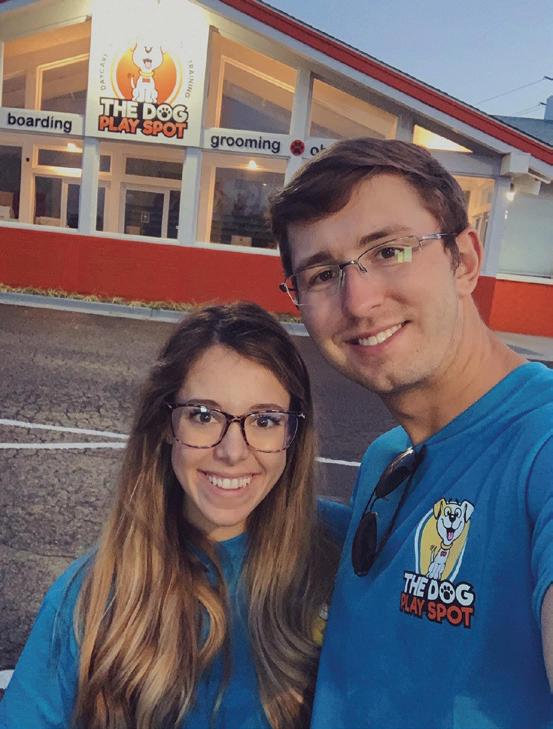
Married: January 2020
Residence: Goldsboro

Future home: Wilmington
Favorite business: The Dog Play Spot
LIFE OF THE PARTY
By Katherine Snow Smith
Kenny Mann thought he and his Liquid Pleasure bandmates had a real shot at a music career when the group landed a contract with the Hit Attractions booking agency in 1981.
More than 40 years later, Mann debated which Raleigh restaurant to choose for dinner with a top executive of Richmondbased East Coast Entertainment, which has represented the group since 1990. e agent wanted to schmooze the veteran musician, who chose Perry’s Steakhouse & Grille in northwest Raleigh.
From choosing venues to negotiating contracts, Mann, 68, is in the driver’s seat now that Liquid Pleasure is one of the best-known U.S. wedding bands. e group also entertains at events sponsored by Fortune 500 companies, nonpro ts, professional sports teams and at presidential inaugurations.
“When Barack Obama got elected, we got that call to pack our bags and come to D.C. I was overwhelmed with emotions,” says Mann. “I got up the next day and looked at every major headline around the world, and it had Obama’s inauguration schedule. Seeing Liquid Pleasure’s name even in the Moscow newspaper, it didn’t get much better than that.”
At an o cial Obama ball, the band shared top billing with fellow North Carolina native James Taylor. at followed similar performances at inaugural events for Presidents Bill Clinton and George W. Bush. ey’ve also played at Mar-a-Lago, the Florida resort owned by Donald Trump.
e group formed in 1966 when the original members were in middle school in Chapel Hill. Now, they y to Florence, Italy, and Cabo San Lucas, Mexico, for weddings a few times a year. An overseas wedding reception with all 14 performers can run about $75,000, which covers as much as $40,000 in travel and other costs.
High-end domestic performances are closer to $30,000, while the band lls in its calendar of 110 shows a year with lower-ticket appearances such as the recent 75th Anniversary Gala for the Chapel

Hill-Carrboro NAACP or the free North Hills summer concert series in Raleigh.
“We have a version of Liquid Pleasure for every price range,” Mann says. “We do charity events for much less.”
ACADEMIC ROOTS
In the ‘80s, the band’s main clientele was fraternities and sororities, rst at southern schools and eventually at some Ivy League campuses. Mann quickly realized that the partying college kids would become brides and grooms seeking wedding entertainment in a few years.
“ ey’re a loss-leader. You get so much business from those parties that turns into wedding and corporate events,” he says, Indeed, Michelle Robinson, a Chicago-born coed who attended Liquid Pleasure events in the early 1980s at Princeton University, had something to do with a future inaugural celebration a er she had married Obama.
Liquid Pleasure is a longtime hot commodity for East Coast Entertainment. “ ey travel the United States on a more regular basis than any of our bands,” says Barry Herndon, a managing partner in Raleigh. “Liquid Pleasure goes from North Carolina to Texas to California and to all points in between. I’ve booked them in Montana for August.”
He credits the musicians, dancers and back-up singers for their talent and strong work ethic. Liquid Pleasure has never canceled a show, even it meant chartering a private plane at the band’s expense or driving through the night when commercial airlines canceled ights. e band’s chemistry with each other and the audience are also key factors to its longevity.
Mann has been performing since fourth grade, when he took piano classes in an a er-school music program on the UNC Chapel Hill campus. But his key role is as a frontman and businessman. His easy dialogue and wise cracks with college kids, CEOs and great-
16 BUSINESS NORTH CAROLINA NC TREND ›››
Entertainment
PHOTO
PHOTOGRAPHY
Superstar wedding band Liquid Pleasure keeps loosening up crowds in its fifth decade.
CREDIT: BILL REAVES
grandmothers have endeared Liquid Pleasure to audiences as much as the band’s catalog of more than 2,000 songs.
“Kenny has a great ability to emcee. He’s a charmer. He knows how to make people feel special,” Herndon says. “He’s the master of everything. He’s hilarious. He’s witty. He’s got a personality that people warm up to.”
Mann’s skills were on full display with a crowd of about 500 at Swansboro’s Mullet Festival in October.
“Raise your hand if you love your wife,” he instructed folks sitting in folding chairs or slightly swaying to the music. “Well, if you love your wife and want her to keep putting up with your sorry self, ask her to dance for this next song.” Couples who haven’t slow danced in years were soon laughing and swaying to The Temptations’ “My Girl.”
A BUSINESS DECISION
Not all of Mann’s stage manners have been innocuous.
When Liquid Pleasure was fresh on the college fraternity circuit in the early ‘80s, he suggested a contest to loosen up a crowd at the University of Alabama. Mann was a devotee of the coarse comedy of another Chapel Hill band, Doug Clark and the Hot Nuts, as well as comedian Richard Pryor. So he invited fraternity boys to come up on stage and see who could yell the N-word the loudest.
His bandmates had mixed reactions, from rolling their eyes at Mann’s antics to quoting Black empowerment leader Malcolm X after the show. Once the hesitant audience got going, Mann established Liquid Pleasure as a band that wanted its crowd to have fun and let loose.

They charged $500 extra for fraternities trying “the contest” for about nine months, then cut it off. By then the group was in high demand, not for the self-deprecating gimmick, but for its music and personality.
When asked if the racial slur contest was worth it, Mann says: “We became the No. 1 fraternity band in 18 months so, business wise, yes. But morally, no. But, you know, I don’t think I would change it. It was important to separate your band from competitors.”
The tension felt by Black musicians playing for mostly white audiences is something Mann has pondered throughout his career, he noted in an 2019 Oxford American story. He explained how the band has used its business success for positive causes, such as improving the segregated neighborhoods where members grew up.
“We’ve got to keep making money,” he said.
Early in his career, Mann made a shrewd business decision that paid off when the pandemic hit in 2020.
“Ninety percent of our calendar got canceled in two weeks. I felt like I was on the musical Titanic,” he says. “But fortunately, we had done what most bands had not done. We had set ourselves up as a legitimate business. We pay taxes. So when the PPP loans came out, we got two of those.” The bands’ federal government pandemic loans totaled $37,380, and were both forgiven, filings show.
While talent is foremost when Mann fills the rare open position, the ability to mesh with his group is also important.
“We don’t smoke. We don’t drink,” he says. “So the people who came into the band who smoked and drank and did all that stuff, if they were really talented, we’d put up with them. If they could be substituted, we’d ease them on out.”
HOMETOWN HISTORIAN
Mann’s roots run deep in Chapel Hill and Carrboro. His father, Kenny Mann Sr., was the revered cook at The Rathskeller from 1949 to 2003. The restaurant’s lasagna with cheese that stretches from table-to-mouth is his recipe. His mother, Effie Marie Mann, taught protestors how to lie in the street for peaceful protests.
Kenny Mann Jr. was one of the first Black students to attend Carrboro Elementary School in the 1960s. A classmate, Sharon Smith, joined a middle-school precursor to Liquid Pleasure. She was UNC Chapel basketball coach Dean Smith’s daughter.
“Sharon was so pretty that we figured we were going to have her in the band one way or another,” he recounts. “She sat right beside me in band class. She played the clarinet. We weren’t going to play any Benny Goodman, but she had the personality and the look.”
He recalls seeing Sharon’s legendary father march in protests against Chapel Hill’s segregated restaurants. “Dean Smith and all of Brinkley Baptist Church were there. He wasn’t hiding in the background, he was right up front.”
He also saw James Taylor singing carols in the city’s Christmas parade. Taylor’s first album in 1968 was released by the Beatles’ newly formed label, Apple Records.
“One day we looked up, and at the Carolina Coffee Shop there was James Taylor and Paul McCartney sitting in there,” Mann recalls. “Seeing Paul McCartney in Chapel Hill was a big day for me.”
Any day with Liquid Pleasure on stage is also a big day. ■
17 MAY 2023
Liquid Pleasure kicked off the Follow Me to Fuquay-Varina signature outdoor concert series in April.
PHOTO CREDIT: ROBERT LOUNSBERRY
SPIRITS IN THE PINES
By Emilee Phillips
Since its 2014 founding, veteran-owned Southern Pines Brewing Co. has grown to become one of the state’s largest cra -beer producers, and has added a second taproom in its Moore County hometown.
e brewery is led by Micah Niebauer, who co-founded the company a er retiring from the U.S. Army’s Special Forces unit. Now the sole owner, he’s adding Southern Pines Spirits, which o ers ready-to-drink canned cocktails.


RTDs, as they are called by insiders, are the fastest-growing alcohol category nationally with supplier revenue gaining 42% to reach $1.6 billion in 2021, according to the Distilled Spirits Council of the U.S. Convenience is a key factor: People don’t have to invest as much to mix their own cocktails and they can drink one wherever they are. A 4-pack sells for $15.95.

e Southern Pines brewery’s goal is to foster community “and we do that through continuously reimagining the cra beverage and hospitality experience,” Niebauer says. “Why not keep evolving, and using the equipment and talented people that we have to enter into new market sectors?”
A few N.C. brewers share that enthusiasm. In 2018, Raleigh brewery Lonerider released a bourbon whiskey nished in sherry casks. A year later, the brewery debuted its “Whiskey Mule” RTD cocktail. It is now available at many bars, restaurants and most ABC stores statewide.


“Our sales have been steadily increasing each year since its launch. One good thing about the pandemic, people gravitated toward things like canned cocktails,” says Derek Tenbusch, vice president of marketing for Lonerider. Lonerider has ve tasting locations.
Canned cocktails have been on Niebauer’s radar since November 2021, when he heard that North Carolina lawmakers
might allow their distribution beyond ABC stores and into supermarkets. at restriction remains in place, but Southern Pines Brewing will be ready if the law changes.
“We have all the equipment to do them in-house, and we have a huge competitive advantage over almost every distillery in the state if these start to go into grocery stores,” says Niebauer, who has invested more than $100,000 in the expansion. “ ey don’t have distributors. ey don’t have retail relationships. ey don’t have canning lines.”
Many cra brewers oppose allowing canned cocktails to be sold in grocery stores, fearing a loss of precious shelf space. e state also taxes distilled spirits at a higher rate than malted liquors such as White Claw, which are sold at groceries.
But Niebauer thinks spirits “allows us to cater to more people. Not everyone likes beer and those that do may want something else from time to time.”
Rather than install a still, he secured a federal distillery permit and sourced white-label spirits from existing distilleries. Creating the cocktails was a sort of Willy Wonka science, aiming to create avors that aren’t too sweet out of a can, yet sweet enough that they held their taste when served over ice, Niebauer says.
Niebauer’s team mixed components by hand, canned their creation, and sent it to a Kentucky company that extracted the avor compounds, mixed in a avor additive, and sent it back for approval. e Southern Pines group then tasted the beverage and sent notes back, rinse and repeat, for 12 months. ■
18 BUSINESS NORTH CAROLINA
NC TREND ››› Manufacturing
A brewer moves beyond suds to offer cocktails in a can.
Micah Niebauer
PERFECT TIMING
By David Mildenberg
For 125 years, First Citizens BancShares operated in relative obscurity as the nation’s largest familyowned bank. That changed overnight in March when it plucked $72 billion of Silicon Valley Bank’s deposits and loans about two weeks after the biggest U.S. banking collapse since 2009.
In a transaction negotiated with the Federal Deposit Insurance Corp., the Raleigh-based bank gained 18 branches, received a discount of about $16.5 billion on Silicon Valley’s assets, and gained relationships with thousands of successful tech companies and tech investors at the California-based institution.

First Citizens’ stock, which traded at about $585 in late March, soared to more than $900 when news of the deal broke. In mid-April, shares were trading for about $1,000, putting the company’s market value around $14.3 billion. Its $218 billion in assets puts it among the 20 largest U.S. financial institutions with more than 500 branches in 23 states.

The FDIC took over Silicon Valley on March 10 after depositors pulled more than $40 billion within a few days from the bank, following a multibillion dollar loss on the sale of bonds and other investments hurt by rapid interest rate increases. Under the FDIC agreement, the government will share in any potential losses on the commercial loans acquired by First Citizens over five years. About $90 billion in Silicon Valley securities that were “underwater” will remain with the FDIC.
The deal largely stemmed from First Citizen’ opportunistic style, reflected in more than a dozen previous failed-bank deals negotiated with regulators since the 2008 financial crisis. “First Citizens has a history of troubled banks,” according to Herman Chan, an analyst with Bloomberg Intelligence. “It’s a strategy to grow the bank when times are difficult — to conduct M&A at advantageous prices.” ■
19 MAY 2023 NC TREND ››› Banking
HEALING HOPES
Methodist University and Cape Fear Valley have ambitious plans for training physicians in Fayetteville.
By Tucker Mitchell
Methodist University’s plans to open a medical school in partnership with Cape Fear Valley Health may have raised an eyebrow or two among educational and medical professionals.
Both Fayetteville-based institutions are small relative to their peers, and starting a medical school from scratch is an ambitious project.
But proponents say this tall order appears to be the right order, given the urgent shortage of doctors, nurses and other health care providers. e problem is particularly acute in the rural counties of southeastern North Carolina, all of which are federally designated Health Professional Shortage Areas.
“ ere’s a great need in all (medical) specialties, in all areas, so someone starting a new school that will produce more doctors — hey, that’s good news,” says Dr. Alison Whelan, chief academic o cer for the Association of American Medical Colleges, a Washington D.C., nonpro t that represents 640 institutions.
“ e basic idea of this school, as I understand it, is to bring more providers to a particular area that’s in need, to a rural area, and there is research that indicates that’s a strategy that does work. So, this is a smart strategy, a useful strategy.”
Methodist and Cape Fear have their work cut out for them. Methodist’s plans an initial class of 80 students in 2026 with goal of about 120 per class as the school develops. e school could be home to nearly 500 students when enrollment is maxed out. Medical schools remain oversubscribed, says Whelan, so lling slots shouldn’t be a problem.
at’s good news. But paying for the school will not be as
easy. It’s expensive to hire instructors and establish labs and other space.
Moreover, the existing doctor shortage that plagues so many communities will undoubtedly trouble the medical school as it looks for residency slots for its new graduates down the road. ird- and fourth-year medical students rotate through a series of “clinical clerkships” that form the bulk of their education during those last two years of school. A er that, doctors must serve residencies lasting three to seven years before they’re full- edged physicians.
e training requires doctors or other seasoned medical professionals to serve as preceptors who teach and direct the students.

Methodist’s basic thesis is that students trained in Fayetteville will be more likely to begin their practice in Cumberland County and neighboring counties served by Cape Fear and its six other hospitals or rehab centers. Cape Fear had revenue of $1.17 billion in the 2020 scal year. Plans call for adding nearly 100 beds at the main 524-bed Fayetteville hospital in the next few years.
Alternatively, med school grads may head o for a residency in a far- ung post with a bigger name and not return.
“ at will be a challenge,” says Whelan. “You’d like to keep them all there, and that is the best plan. But there is a serious shortage with regard to the availability of residencies and preceptors. Not every doctor wants to do this. When you spend time with students, guess what? You don’t see as many patients.”
Having Cape Fear Valley as a partner will be helpful, she adds. “Everyone — doctors, the school, the hospitals involved — needs to understand this and see the long-term picture. It’s

20 BUSINESS NORTH CAROLINA NC TREND ›››
Education
good that they have a hospital as a partner. I can’t imagine doing it any other way.”



e Fayetteville system has o ered clinical rotations and post-grad residences for many years. at means that some slots are already spoken for. For instance, Cape Fear has more than 200 residents from Campbell University’s Jerry M. Wallace School of Osteopathic Medicine. Osteopathic schools supply slightly di erent training than medical schools, but put students on the path to becoming a doctor.
Suzanne Blum Malley, Methodist’s provost, calls Cape Fear’s residence program, “a huge advantage as we start a medical school based in Fayetteville.” Prospective residents are “matched” with available residencies through a nationwide system. Methodist’s goal is for its medical students to “match” in the Cape Fear system, but Malley says the school realizes that won’t happen in every case.
Two-thirds of students who complete their medical degrees and residencies in the same area stay in that area to practice, according to the medical school trade group.


Methodist o cials also expect that the in ux of residents and medical students will improve access to medical care. at’s one of many “halo bene ts” that Methodist and Cape Fear o cials project for the hospital’s service area. Including construction, the medical school could lead to more than 800 new jobs. A study by an N.C. State University economist projected the school would add $750 million to the regional economy in the school’s rst 10 years.
“ e advent of the school will have a transformative e ect on the community over time, improving the quality of medical care, attracting and retaining medical care providers and new areas
of specialization, attracting other medically-related businesses, increasing the median income level, adding to the tax base, and bringing in new revenue from the purchase of goods and services,” says Stanley Wearden, Methodist’s president since 2019.
It should also boost enrollment at the university’s health care specialties. Methodist has about 2,300 students and o ers an undergraduate degree in nursing and advanced degrees for nurse practitioners, physician assistants, occupational therapists, and physical therapists.
Funding the expansion is expected to involve a mix of federal grants, tuition income and private donations.
Faculty and support personnel have to be hired. Preceptors rarely work for free either, and residents are paid a stipend. Cape Fear’s current residency program pays $54,000 to $66,000 annually, not including a standard full-time bene ts package.
Methodist, which has an endowment of about $35 million, will own and operate the medical school. e Cape Fear system is contributing to start-up expenses, including the school’s main building, which is expected to cost $50 million. e not-forpro t system had about $614 million of net assets on its balance sheet as of mid-2020. its latest public tax ling shows.
In Charlotte, the heavily promoted plan for a Wake Forest University medical school campus is backed by Advocate Health, which has capital exceeding $12 billion, and major corporate support in the state’s biggest city.
Malley says Methodist can handle the Cumberland County project. “ rough our partnership (with Cape Fear Valley Health) we are prepared for those expenses,” Malley says. “We are also exploring all sources of potential external funding, including government and philanthropic sources.” ■
21 MAY 2023
*School of osteopathic medicine | source: Association of American Medical Colleges MEDICAL SCHOOL STUDENTS (2023) UNC Chapel Hill 893 Wake Forest University 602 Duke University 586 Campbell University* 424 East Carolina University 384
REVVING RESEARCH
By Ray Gronberg
Retired banker Kelly King is leading a public-private e ort to boost commercialization of university research across North Carolina, winning initial support from key lawmakers and Gov. Roy Cooper. A House bill seeks $50 million in state funding, which could lead to a ood of future investment for the project over the next decade.
e money would go to NCInnovation Inc., which contends that the state’s tech-transfer e orts are falling behind peers across the nation. “RTP isn’t the end,” its pitch book says, referring to the world-famous business park in Durham and Wake counties. “It’s just the beginning.”
“Innovation de nes North Carolina’s past, from our research universities to RTP,” says King, the retired BB&T/Truist CEO who chairs NCInnovation’s board. “But if we’re to compete and win in the future, then what we’ve built so far must be only the beginning.
King and other project leaders started conceiving NCInnovation in 2018. Since 2021, the group has undertaken market research, formed a board and raised $20 million from 11 banks, Duke Energy, Blue Cross Blue Shield of North Carolina and other businesses including Capitol Broadcasting, Flow Automotive and Martin Marietta.
Bennet Waters, a former professor in UNC Chapel Hill’s Gillings School of Global Public Health and global security consultant, serves as CEO. e chief strategy o cer is Je Sural, who led the state’s broadband initiative in the N.C. Department of Information Technology from 2015-2021.
e next phase of the initiative would be to advocate for “at least a $250 million annual public commitment over a minimum of 10 years, or $2.5 billion total, supplemented with private resources” to build on existing strengths in agricultural
technology, biohealth, defense innovation, power electronics and cloud computing. It would be a massive expansion by state government.
e group is working on potential hubs and is in talks with leaders of four universities — UNC Charlotte, East Carolina, N.C. A&T and Western Carolina — and the UNC System.
NCInnovation notes that Duke, UNC Chapel Hill and N.C. State account for almost 87% of the state’s academic R&D e ort. With other regions le out, North Carolina has “some of the poorest economic mobility in the country,” and half its counties lost population between 2010 and 2020.
NCInnovation envisions a broader set of regional hubs that can link researchers throughout the state with mentors and funding needed to start and sustain new businesses. ere’s also a need for more venture capital, and access to experienced executives who can help “infuse real-world business acumen into university research commercialization e orts.”
King leads a six-member board that would expand to 36 members, half from the private sector and half from the public sector. Other members are real-estate developer Kirk Bradley of Chapel Hill; retired Wells Fargo banker Stan Kelly of WinstonSalem; former Waste Industries CEO Ven Poole of Raleigh; biotech executive Neal Fowler of Raleigh and Kelly Fuller, who previously led the NC Chamber Foundation.
King, who lived in a rural Wake County home without electric service early in his life, was part of a management team that built what became the seventh-largest U.S. bank a er the BB&T merger with Atlanta-based SunTrust Banks in 2019.
State lawmakers are pressing NCInnovation leaders for more details on the group’s plan, including a comparison with more traditional approaches led by individual universities. ■

22 BUSINESS NORTH CAROLINA NC TREND ››› Statewide
Top execs press unprecedented plan to boost state’s R&D investment.
CHARLOTTE
BELMONT
Wilbert Plastic Services CEO Greg Botner retired after 15 years leading the business, which moved here from Chicago in 2010. Botner started in plastics manufacturing 45 years ago as a supervisor trainee at an automobile manufacturer in Michigan.
CHARLOTTE
Atrium Health CEO Eugene Woods received total compensation of $13.97 million in 2022, a 40%-plus bump from $9.8 million a year earlier. His pay included a $5.4 million bonus and $2.5 million in other incentive pay. Eleven other Atrium executives earned more than $1 million in 2022, including seven who received at least $2 million.
Mecklenburg County hospitals are exempt from $23 million in annual property taxes, according to an analysis. Atrium Health and Novant Health say the tax breaks are offset by massive delivery of discounted medical care. The county is mulling possible property tax increases after a revaluation showed soaring values.
Truist completed its sale of a 20% stake in Truist Insurance Holdings, the sixth-largest insurance brokerage in the United States. Greenwich, Conn.-based Stone Point Capital bought the equity for $1.95 billion, which valued the business at $14.75 billion.
Novant Health, based in WinstonSalem, announced that several high-level executives were among about 50 jobs eliminated by the system. Departing leaders include Jesse Cureton, an executive vice president and chief consumer officer, and Paula Dean Kranz, a vice president of innovation enablement.
I-77 Mobility Partners generated more than $59 million in toll revenue in 2022, almost a 70% increase from the previous year. The average toll transaction was $1.70 last year, compared with $1.20 a year earlier.
Crescent Communities broke ground on its 1,400-acre River District project near the Catawba River. Plans call for 5,000 homes and apartments, millions of square feet of office space, half a million square feet of retail and 1,000 hotel rooms.
KINGS MOUNTAIN
Jason Harris, assistant chief of the Catawba Nation, is running for chief of the Native American tribe. Chief William Harris plans to step aside. The Catawba Tribe owns the Catawba Two Kings Casino here.
SALISBURY
Mid-Carolina Regional Airport is considering adding five new hangars, with
Charlotte-based Charter Jet Transport expected to be one of the first tenants. The private charter company’s clients include the Charlotte Hornets.
STANLEY
Keter US said 65 people would lose their jobs when the manufacturer of outdoor storage devices and furniture closes its local operations. The effective date for the closure is June 30, according to a public filing. The company laid off 68 workers last year.
STATESVILLE
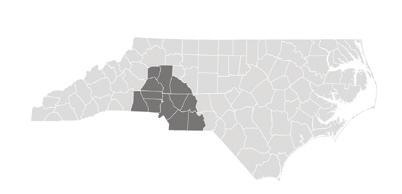
Australia-based environmental remediation company EPOC Enviro will invest $4.1 million and create 226 jobs with its first North American production site. EPOC Enviro manufactures SAFF, which stands for surface active foam fractionation, used in landfills, airports, military bases and sewage treatment sites to remediate PFAS, also known as “forever chemicals.”
CHARLOTTE
Indianapolis-based real estate investment trust Simon Property Group, owner of SouthPark mall, purchased the nearby 124-room Hampton Inn & Suites at Phillips Place for $42 million. The previous owner bought the 0.72-acre site in 1996.

23 MAY 2023
EAST
ELIZABETHTOWN
Peanut sheller Severn Peanut will invest $17 million and hire 44 employees here to upgrade its facilities and improve its peanut butter production. Severn Peanut is a division of South Carolina-based Meherrin Agricultural and Chemical Co. It has been in business for more than 75 years.

LAURINBURG
Pilkington North America will make $86.8 million in improvements at its glass manufacturing plant and create 20 jobs. The UK-based company produces float glass for the architectural market at its Scotland County plant.
TOPSAIL BEACH

The town planning board reviewed a proposal submitted by Pendo CEO Todd Olson to create a family compound on the southernmost tip of Topsail Island, amid opposition from neighbors. Olson is one of the state’s most celebrated tech executives. The board has about two months to rule on the application.

WILMINGTON
nCino reported a loss of $103 million for 2022, compared with a deficit of $49 million a year earlier. Revenue increased 49% to $408 million as more banks signed up for the company’s software services. The company reduced its workforce by 7% in January.
GREENSBORO
TAT Piedmont Aviation, a maintenance, repair, and overhaul company, expanded its operations near the Piedmont Triad International Airport with a $12.8 million investment that created 85 jobs.

Aswani Volety, a first-generation college graduate and India native, was installed as the seventh chancellor at UNC Wilmington. He is a former dean of UNCW’s College of Arts and Sciences.
TRIAD
ASHEBORO

Vann York Auto Group bought two dealerships here. The acquisitions of Strider Subaru and Strider Buick GMC are the seventh and eighth locations of High Pointbased Vann York.
GREENSBORO
Omega Sports will close its seven stores two years after filing for Chapter 11 bankruptcy protection. Founded by Phil Bowman and Thom Rock in 1978, the retailer was acquired by former Fresh Market CEO Craig Carlock in 2017.

24 BUSINESS NORTH CAROLINA NC TREND ››› Statewide
The Department of Justice seized $5.2 million from Gate City Transportation, which was convicted on one count of healthcare fraud in 2018. According to court records, the medical transport company misrepresented its services on reimbursement applications from November 2010 until February 2015. More than $5.5 million will be paid to the victim.

Imperial Brands is repurchasing $620 million of company stock as part of a $1.24 billion share buyback program. The U.K.-based parent company of ITG Brands said the program runs through Sept. 30. Imperial Brands sells cigarette, cigar and e-vapor brands

WINSTON-SALEM
Collins Aerospace plans to lay off about 195 employees by June 30. The company, which said the layoffs would be permanent, blamed the move on continued weakness in demand in the aircraft industry.

25 MAY 2023
TRIANGLE
ABERDEEN
Habitat for Humanity of the Sandhills bought more than 100 areas in Moore County. Executive Director Amie Fraley of Sandhills Habitat for Humanity cited the project at a Habitat event that raised more than $250,000.
RALEIGH

10 Federal, which operates about 75 self-storage facilities in 16 states, raised more than $30 million for further growth, including three new Georgia sites. Brad and Cliff Minsley started the business in 2010.

PNC Arena, better known for hockey and college basketball, hosted the North American League of Legends esports event, drawing an estimated 8,000 spectators. It’s the second major esports event for PNC, having hosted the Apex Legends Global Series Year 2 Championship in July.
Life sciences firm ProPharma will relocate its global center here from a Kansas City suburb. The regulatory consulting firm, which was founded in 2001, estimated its new headquarters will bring 75 to 100 new jobs to the area in the next two years.
DURHAM
WEST
ASHEVILLE
A lawsuit filed by two cardiologists against a clinic affiliated with Mission Health and HCA Healthcare was dismissed. Both physicians are now working at UNC Health Care-affiliated Pardee Memorial Hospital Foundation.
CANTON
The Haywood Waterways Association received $2 million from the North Carolina Land and Water Fund, aimed at mitigating the floods that have repeatedly along Haywood County’s Pigeon River. It’s the largest grant in the association’s history.

CARY
SAS Institute owner Jim Goodnight is the richest person in North Carolina with an estimated net worth of $7.4 billion, according to Forbes’ annual list of global billionaires. Tim Sweeney, the owner of Epic Games, has a net worth of $4.7 billion, down from $7.4 billion a year earlier, the magazine reported.
Outbreaks plans to start sales of its first over-the-counter medicine, having raised $500,000 from nine investors. The company’s first product is an all-natural solution for treating cold sores. The cold sore market was valued at $825 million in 2021.
MORRISVILLE
Jaggaer CEO Jim Bureau left the procurement software company after more than three years in the role. Jaggaer, which confirmed layoffs in December, has more than 1,100 employees.
Startups in the Raleigh and Durham metro areas raised more than $414 million in the first quarter, according to the PitchBook research firm. That’s an increase of 34% from the previous quarter and 61% year over year.
Sports technology firm Teamworks raised $65 million to spur expansion. The company started by former Duke University football player Zach Maurides has raised $165 million overall. It employs more than 300 employees, many of whom are remote.
SILER CITY
Durham-based Wolfspeed , a manufactur er of chips for electric vehicles and other products, would emit a half dozen air pol lutants at its new Chatham County plant, totaling 203 tons per year, state documents show. The factory is expected to create 1,800 jobs. The Division of Air Quality is still reviewing the permit, which will be subject to public comment.
RUTHERFORDTON
FreightWorks Transport announced 180 workers, including about 140 truck drivers, lost their jobs immediately when the company shut down after 11 years of operation. Company leaders said some major customers had demanded “massive rate and volume concessions,” resulting in major financial losses. ■

26 BUSINESS NORTH CAROLINA NC TREND ››› Statewide
ABERDEEN PHOTO CREDIT: BJ GRIEVE

BIOTECH BOOM





As North Carolina lands new biotech companies and longtime industry employers continue to grow, a shortage of staff to fill the jobs has evolved. But leaders in biotech education and business are confident new programs and better outreach will meet employers’ needs and advance the careers of N.C. students and workers.





28 BUSINESS NORTH CAROLINA SPONSORED SECTION 28 ROUND TABLE BIOTECHNOLOGY
Photography by Bryan Regan
Doug Edgeton president and CEO, North Carolina Biotechnology Center
Bernadette Donovan-Merkert professor of chemistry, University of North Carolina at Charlotte
NORTH CAROLINA
John Kegerise vice president, CSL Seqirus
Central Carolina Community College, CSL Seqirus, The NC Biosciences Organization, North Carolina Biotechnology Center, UNC Charlotte, UNC Nutrition Research Institute sponsored the discussion. It was moderated by Ben Kinney, publisher of Business North Carolina. It was edited for brevity and clarity.
WHAT ARE SOME NEW THINGS HAPPENING IN BIO MANUFACTURING AND RELATED INDUSTRIES THAT NORTH CAROLINIANS SHOULD KNOW ABOUT?





EDGETON: For NCBiotech, we have been working on ways to better prepare the life sciences workforce in our state. Part of that effort is via the Federal Economic Development Administration’s (EDA) Build Back Better Regional Challenge (BBBRC) grant. NCBiotech coordinated the request for proposal response among 28 partners spread across North Carolina. Our state was one of 60 EDA BBBRC awards out of 529 proposals submitted nationwide.
The purpose of this award is to stimulate career opportunities for people in locations that have not historically benefited from employment in the rapidly growing life sciences sector. This is particularly true for eastern North Carolina. The Phase 2 BBBRC award provides about $20 million to the community college system for buying equipment to provide training. Another $5 million will go to the Historically Black Colleges and Universities (HBCUs) and one Historically American Indian University (HAIU) for more advanced training programs in biomanufacturing. Lastly, NCBiotech will utilize about $1.5 million to create and execute a campaign targeting North Carolina residents to raise awareness about training and career opportunities in this growing field.
One of the big challenges is that many people do not know these jobs exist. If people are aware of the career opportunities, they may not know where to look to secure training or employment.
WAGNER: The Biotechnology Center and the Commerce Department working together did a great job over the last five years bringing a lot of new projects, both expansions of existing and new projects to the area. There’s a lag of two or three



years from groundbreaking to hiring. … They’ve got to build these facilities before they start hiring, but (the hiring) is hitting now. What’s happening initially now is companies are just stealing from each other. Employees are moving from one to another. They tend to migrate toward startups. So we really need to work hard to make the pie bigger, so that there are more workers and it’s just not shells moving back and forth. And I think that’s the biggest focus right now.
KEGERISE: The problem John (Wagner) identified around the amount of talent in the area also continues as those companies grow and their expansions come live. We recently completed our own expansion at CSL Seqirus but there is more construction underway. We have a lot more jobs than we do people in the area. Our solution has been to look at different geographical areas or different partners who we can collaborate with to bring in new talent. We need to think about how we advertise that the pharmaceutical industry has a variety of different needs and a variety of different jobs. You don’t need to be a chemist or a biologist to have a job in the industry. You can be a finance major, for example, or you could work as a mechanic.
29 MAY 2023
Scott Ralls president, Wake Technical Community College
Lisa Smelser program director for biotechnology, Central Carolina Community College
John Wagner program manager, Biotech Manufacturers Forum
WAGNER: Many people are intimidated by the biotech industry. You don’t need to be a Ph.D. in chemistry, biology or whatever to work. In fact, most of the jobs don’t require a technical degree. We need to get that word out, especially in some of the underrepresented populations.
SMELSER: Community colleges really can provide some of that service. At Central Carolina specifically, we’ve trained over 300 people through our Biowork program since May of 2020. And the best part of what I get to do is see these people who maybe have some college and they really want a better life for themselves go through this shortterm training program to connect to an industry role that is extremely meaningful for them … and gives access to these great paying jobs.
BERNADETTE, FROM A UNIVERSITY STANDPOINT, WHAT ARE YOU HEARING FROM FOLKS REGARDING THIS?
DONOVAN-MERKERT: The state has really supported UNC Charlotte. For example, we opened a new science building that brings research and education together by housing stateof-the-art undergraduate teaching laboratories in chemistry, biology and physics along with research laboratories in which faculty and students from these same disciplines conduct research in the broad area of biomolecular sciences. The building has open spaces and is designed to promote collaborations. We have graduate students conducting research, but undergraduate students as well. We have incredibly strong opportunities for undergraduate research at UNC Charlotte.
HOW DO BIOTECH ENTITIES COLLABORATE WITH EACH OTHER AND THE COMMUNITY?
SMELSER: At Central Carolina, we have instituted a biotech industry leadership team. We are very dedicated to making sure that our trainees have the right skills. We need someone with that expertise to share that information and share it in a way so that we come full circle on it. We go through our curriculum every single year, look for any gaps and then make sure that we’re filling those gaps. This is either with existing equipment that we have or the Build Back Better grant allows us to respond to new technologies, whether it’s automation, or something in the cell and gene therapy space. So having that feedback, that we’re able to really show that we’ve done things, I think that puts

SPONSORED SECTION ROUND TABLE BIOTECHNOLOGY 30 BUSINESS NORTH CAROLINA
us at the forefront of our trainees having the right skills.

EDGETON: By having 10 of our community colleges participating in Biowork, it allows us to have a common platform from which people can learn, get a certificate, and be trained for entry-level jobs. At the same time, we’re turning out 5,200 biological and biomedical degrees each year from our university system. We have another 4,600 or so engineers coming out each year as well. Historically, we’ve been able to meet the workforce needs. But, in the last four years, we have brought in about 12,500 new jobs, which is great for the state and for anybody who’s looking for a job. As a state, we set up our biotech education a long time ago and have continued to support and grow it. It has been very
beneficial in recruiting more companies. North Carolina has a network that’s phenomenal at collaborating as a team in industry, academia, and government. We wouldn’t have gotten the BBB grant had we not already had the training infrastructure and connections formed.
RALLS: It seems like we are collaborating almost every week. At Wake Tech, I like to say we’re tripling down, we’re not just doubling. Over a year ago, we opened the first of what will be four new facilities that have a key biotech or biopharma base. We split out our degree programs into biotech and biopharma. Biotech is in our new Lilly building on the RTP campus. (Built in honor of a $1.1 million contribution from Eli Lilly and Co.) We’re building a really unique biopharma simulated work environment and a new training
facility in Holly Springs. The jobs are here, and we have to scale to meet the demand. We’re scaling as quickly as we can, whether it be facilities or degree programs. Our short-term Bioware programs are about 50% larger now than this time last year.
Four years ago biopharma was one of 252 program areas at Wake Tech, now it’s one of 13 career fields. We have a dean for biotech. We’re tripling down in terms of our investment in this area. … Another thing I think that’s really unique here in this region is the ecosystem. We have an early college high school on our RTP campus That is for information and biotechnologies. The biotech students take a community college genetics course their senior year that has been designed in concert within the state that will transfer to N.C. State. So you see the ecosystem kick in whether
31 MAY 2023
it’s the public schools, community colleges, universities and the companies coming together to make that happen. I don’t think you find this in other states.
WAGNER: An implementation group was created back in 2003 or 2004. We’ve continued to meet five times a year with representatives from the Biotechnology Center and community colleges. Several others get together and we talk about topics that could have an impact. We make sure that they’re getting funding for those types of things that they need. So it’s an ongoing communication and coordination. We have the biomanufacturing forum. We meet four times a year and we talk about various topics that are critical to the industry and some of our best practices. John (Kegerise) is one of the seats in the room for CSL Seqirus along with about
12 other large companies. They compete for resources, there’s very little product competition. But they also understand that they need so many common things that are not intellectual property related and so on that they can help each other out and then we all win.
KEGERISE: I would also comment on what Lisa touched on a little bit, which is our ability to work with the ecosystem to customize our training. There’s a continuous dialogue between the local educational institutions and industry to say, “Hey, you know, you can get a degree in X, Y or Z.” But from a training standpoint, there are some things we need to prepare folks for the industry — things like aseptic training and best practices. That sort of dialogue between the industry and the educational institutions is what’s going to enable the
success of all the infrastructure that’s being built here, right now. Beyond the initial training, training for employees that you’ve already got is important as well. There needs to be a capability to send people that are already employed by your company into a training program to prepare them for the next step in their career. There is amazing opportunity in that as well.
BERNADETTE, HOW DO YOU COLLABORATE WITH FOLKS IN THE CHARLOTTE REGION AND WITH THE STATE?
DONOVAN-MERKERT: One of the things we have on campus is the PORTAL building and that’s for business partners to actually come to campus. They have office space, they also can use labs throughout the university. They pay a
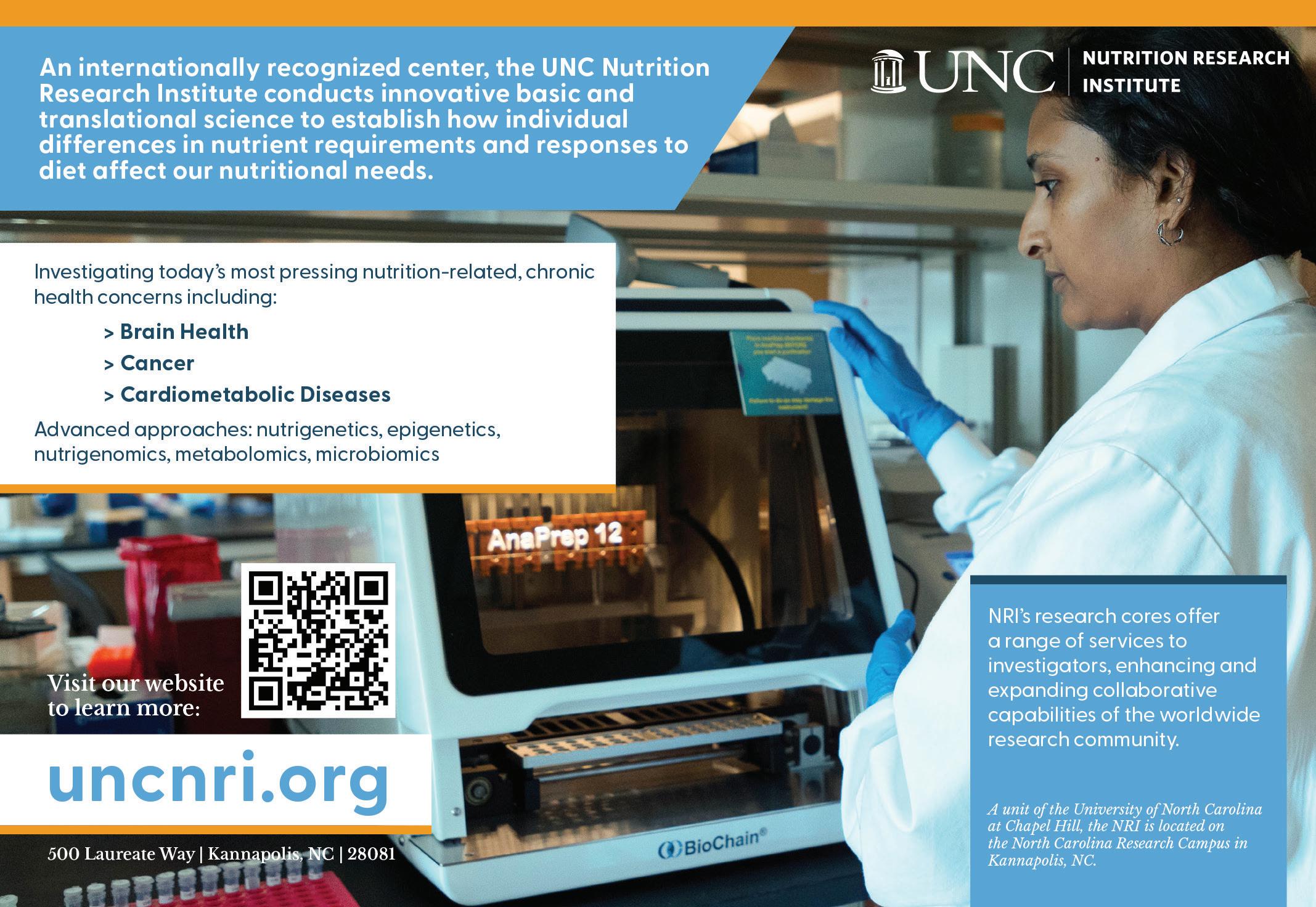
SPONSORED SECTION ROUND TABLE BIOTECHNOLOGY 32 BUSINESS NORTH CAROLINA
membership fee for access to basically all the facilities on campus as well as the students and faculty to consult with. We also have a biotechnology program, that’s actually a certificate program where a student may be majoring in chemistry or biology and take some additional courses in biotechnology, then they do an internship with a local company.
HOW ARE YOU ADDRESSING THE WORKFORCE SHORTAGE?
EDGETON: Some of the things that we’re focused on include the large population of veterans, who have finished their military careers in North Carolina. We have a program called MOVE, which stands for Military Outreach and Veterans Engagement, for mobilizing our veterans toward careers in the life sciences.
About 35,000 people per year finish their military career here in North Carolina. Veterans have been well trained at following protocols and procedures. So, they make great employees for our companies. That’s a program that we’re very proud of and it is just getting started.
Another program we’re proud of is in Greenville. In Pitt County Community College and East Carolina University, there’s the Pharmaceutical Services Network (PSN). It targets students who are graduating from high school from the poorest areas who have no plan to go to college, and no ability to pay for college. NCBiotech teamed up with Thermo Fisher Scientific (a pharmaceutical development and manufacturing company). We give these students a chance to take the PSN training program. Almost immediately

after they graduate high school, they go through this certificate program. A week later they’re interviewed by Thermo Fisher. We’re now in our third cohort and there have been about 18 students who went from not having any plans to having a promising career.
KEGERISE: We’re widening the pool of candidates to include more diverse backgrounds. The veteran community is a perfect example. CSL Seqirus has many veterans who are applying right now. Veterans are an extremely good fit for this industry. While maybe they have no explicit biotech background, they always come in with an extremely high learning agility from the training that they’ve got from a military background. They’ve been under various scenarios of intense pressure in a time crunch. Biotech manufacturing comes with its set
33 MAY 2023
of circumstances that can be somewhat stressful. The veteran hires deal with that stress quite well from day one.
WAGNER: The broader pharmaceutical industry, including biotech for decades, had the luxury of doing what I call passive recruiting. They posted a job and they’d get 1,000 applicants. That has changed … and they have to figure out a different way of recruiting and reach populations that may not be looking at our industry. We’re working on some options, which I don’t want to get into because it’s early … but it’s about how collectively as an industry we can reach (potential employees.)
RALLS: So many of the people who live around the facilities have no idea what happens in those facilities. And if you can’t see it, you can’t see it. And a lot of times these are not things that you see when you’re considering what are the opportunities that are in front of you.
SMELSER: Scott, I grew up 30 minutes from the Pfizer site in Kalamazoo, Michigan, and while I had brand recognition of Pfizer, I had no idea what jobs were there. At Central Carolina, we are uniquely very word of mouth and community based. Trust has been a huge part of the way that we operate.

Specifically, our president, Dr. Lisa Chapman, has reached out to faithbased leaders and made sure they can share the opportunities of CCCC and area employers. We’ve been meeting with all types of community leaders, sharing some of the opportunities so that even if they do have brand recognition of Seqirus or Pfizer or our other companies, they know how they can get to jobs, and they know what those jobs look like. So being able to operate from a place of relationship building and trust has been a huge part of what we’re doing at Central Carolina.
DONOVAN-MERKERT: We are really committed to encouraging young people to pursue studies in the sciences. One of the programs we have is the ACS (American Chemical Society) Project SEED Program. This is a program that brings high school students from economically disadvantaged backgrounds to campus during the summer months and provides them with a stipend to conduct research in faculty labs. Another example is the Charlotte Research Scholars program, which funds about 50 undergraduate students to conduct research each summer. In addition to conducting research, students have the opportunity to participate in professional development workshops,
and they present the results of their research at a campuswide conference at the end of the summer. We also have several undergraduate research programs supported by the National Science Foundation.
ALONG WITH NEW WAYS OF BRINGING IN WORKERS, WHAT CAN BE DONE TO CREATE A VERY DIVERSE GROUP OF WORKERS?
EDGETON: Part of the Build Back
Better grants focuses on internships and apprenticeships. If you can get people placed in an internship or apprenticeship, they can see what a biotech career is like. That’s a big first step.
I am confident we can increase workforce diversity and bring in people who have historically not seen themselves having a career in science. United Way partnered with Novozymes to build a mobile innovation lab, which is just a van with a small learning lab that can be taken to different schools to show experiments and introduce people to science at an earlier age.
We need to find young people who are maybe in their high school years and are looking for where to go next. We are finding ways to connect with those people and help build this pipeline of future employees.
SMELSER: I think it comes down to accessibility, and we’re operating from a place of inclusion. In terms of accessibility, we could be talking about access to high tech equipment, like Scott mentioned earlier, and at Central Carolina, we’re working to build our capacity. Right now, we’re working with our partners at the Capstone Center, and doing some training that we don’t currently have the capacity to do (on campus). A former Magneti
SPONSORED SECTION ROUND TABLE BIOTECHNOLOGY 34 BUSINESS NORTH CAROLINA 34 NORTH CAROLINA

Marelli auto manufacturing plant will become the new E. Eugene Moore Manufacturing and Biotech Solutions Center. So not only will we have a place for biotechnology to live, we’ll also have a place to train all of the different roles, like maintenance technicians that you mentioned earlier. Automation technicians are another role that we’ll have there.
I’ve got to be able to respond to a rotating manufacturing shift schedule so that people can have access to these training programs, whether they’re an adult looking to transition, whether they work at Seqirus and are looking to further their education. They need to actually be able to have that as an option for them in order to move forward. We need night classes,
morning classes. An attitude of inclusion is being flexible, as opposed to being rigid, which excludes people.



RALLS: I think part of who we are as community colleges is we’re very inclusive. But we have to reach out more and we have to help students who might live in one part of our community, get to the jobs that are in the other part of the community. So transportation is part of that. Also, one of the things we’re really focused on at Wake Tech is a philosophy we call ladder economics. What we mean by that is you have to kind of chunk the opportunities or show rung by rung of how to get there.
We have a nondegree program that we’re offering free of charge. Someone may think, “I can carry eight credits into a biopharma degree. If I get a job (in that field) I can finish that degree. But then I could get an apprenticeship while I’m doing that degree possibly.”
KEGERISE: Diversity is foundational. The life sciences industry is built off of and sustained by innovation. Diversity of thought drives innovation, and frankly, we won’t survive as an industry without it. What’s exciting to me is if we think








about all the previous questions you’ve asked us today, elements of diversity came out in every part of the discussions. We talked about veterans, we talked about access to education. We talked about reaching out to underprivileged communities. All within this discussion today, before you even asked that question, which tells me it’s at the forefront of the industry’s mind.
DONOVANMERKERT: About 40% of the students at UNC Charlotte are from underrepresented or underserved populations. We have the students, and we provide opportunities for them to succeed and to see that they are welcome in the sciences. We provide lots of support for students, such as tutoring and peer leaders. Many students are taught in active learning classrooms, where they immediately get to practice what they have learned. Many courses incorporate research experiences in which students work on individual or team projects of their choosing. In some courses, the instructors ask the students: “What research do you want to do?” They then design the course around the type of project that the students are interested in. ■
SPONSORED SECTION ROUND TABLE BIOTECHNOLOGY 36 BUSINESS NORTH CAROLINA

VETERAN COMMUNITY
by Alyssa Pressler
With eight active military bases across the state, it’s no surprise there’s a large military population in North Carolina. Fort Bragg alone, which is set to be renamed Fort Liberty in June, is one of the largest military bases in the world by population. The veteran population and veteran-owned businesses are a major driver for the state’s economy, as you’ll read in the following profiles. Organizations across the state are focused on supporting and hiring veterans as well as helping them develop their own businesses.

SPONSORED SECTION N.C. PORTRAITS VETERAN-SUPPORTED BUSINESSES 38
PHOTO CREDIT:
BUSINESS NORTH CAROLINA
SENIOR AIRMAN BRITTAIN CROLLEY
For more information or to contact the NCMBC visit: www.ncmbc.us
SMART BUSINESS
e North Carolina Military Business Center was created by the General Assembly in 2004 with the goal of leveraging military and other business opportunities to grow businesses, jobs and the defense economy across the state.

Since then, Executive Director Scott Dorney states the organization has helped businesses bring more than $17 billion in federal revenue into the state. Just last year, the NCMBC played a role in helping contractors win 530 prime contracts, which contributed to the $8.93 billion in federal contracts awarded to businesses in North Carolina.
e state entity considers itself a business development organization. While part of its focus is ensuring the veterans transitioning out of the eight North Carolina military bases stay in the state to contribute to the economy, a large part of their work is helping small and other businesses win federal prime and subcontracts.
“Prior to establishing the NCMBC, what was missing in growing defense contracting was someone to connect defense opportunities to our business capacity, and to provide technical support to help great businesses win,” Dorney says.

He’s quick to clarify that he and his team are not responsible for winning the contracts — they’re won because the business chosen has the best product or the best service at the best price. But the NCMBC plays a supporting role in getting more businesses registered to bid, competing for and successfully executing federal contracts that make sense for their businesses.
Each contract won means more jobs and an expanding business community in North Carolina, including veteran-owned and veteran-operated businesses. It’s a win-win, but Dorney says businesses need to register with the NCMBC’s public facing database (www.MatchForce.org) to reap the bene ts, no matter what their business does.
“Some might think they can’t be government contractors, or that the government does not buy what they sell,” he says. “Whether they’re making weapons, painting houses, or selling ice cream, there’s no doubt the government buys it — and wants to do business with small businesses in North Carolina.”
39 MAY 2023
1ST
PHOTO CREDIT: ARMY SGT.
CLASS LISA LITCHFIELD











SPONSORED SECTION N.C. PORTRAITS VETERAN-SUPPORTED BUSINESSES 40 BUSINESS NORTH CAROLINA








 BY EBONY MORMAN
BY EBONY MORMAN
Welcome to our annual guide to the state’s higher education sector. North Carolina has 16 public universities, with its largest, North Carolina State University in Raleigh, enrolling nearly 37,000 students. e smallest is UNC School of the Arts in WinstonSalem, which has about 1,100 students. Also, the state is home to 58 private institutions and 58 community colleges, for a total of 132 di erent institutions.




is list, compiled from data from the UNC System and the National Center for Education Statistics, looks beyond enrollment gures. It also lists overall costs, including tuition, fees and room and board, where applicable, based on the 2021-2022 school year, plus the average nancial aid awarded at each institution (based on 2020-2021 school year). For public universities, N.C. State tops the list at $24,986 for in-state students and $45,771 for students out of state. e state’s public universities haven’t raised in-state tuition for seven consecutive years, though other costs have increased.
Duke University and Davidson top the private schools with estimated costs of $79,860 and $73,200, respectively. Both campuses provide average nancial aid awards of about $42,000, making them accessible to more students.




is list also describes acceptance rates; student-faculty ratios; gender ratio for full-time undergraduate students; and the percentage of diverse students, based on non-white students enrolled in the fall of 2021.
e overall retention rates refer to full-time students who began in the fall of 2020 and returned in 2021. Graduation rates track the progress of full-time students who entered school in fall 2015 to see if they completed a degree within 150% of “normal time,” typically six years. Community college statistics are for 2021-2022.
e list also provides information on the 32 colleges and universities o ering MBA programs, including online options.

42 BUSINESS NORTH CAROLINA
2023
PUBLIC UNIVERSITIES
APPALACHIAN STATE UNIVERSITY BOONE, APPSTATE.EDU
Total enrollment: 20,641; undergraduate enrollment: 18,555; contact: 828-262-2120, admissions@appstate.edu; freshman applicants/ accepted: 21,120/17,952;student/faculty ratio: 17/1; (85%); total cost (in-state/out-of-state): $20,799/$36,406; average financial aid awarded: $8,184; retention/graduation rate: 86%/73%; undergraduate male/female: 43%/57%; diverse students: 19%
EAST CAROLINA UNIVERSITY GREENVILLE, ECU.EDU
Total enrollment: 28,021; undergraduate enrollment: 22, 463; contact: 252-328-6640, admissions@ecu.edu; freshman applicants/ accepted: 21,898/20,548 (94%); student/faculty ratio: 18/1; total cost (in-state/out-of-state): $23,215/$39,492; average financial aid awarded: $7,604; retention/graduation rate: 81%/66%; undergraduate male/female: 41%/59%; diverse students: 37%
ELIZABETH CITY STATE UNIVERSITY* ELIZABETH CITY, ECSU.EDU
Total enrollment: 2,054; undergraduate enrollment: 1,956; contact: 252-335-3305, admissions@ecsu. edu; freshman applicants/ accepted: 3,373/2,597 (77%); student/faculty ratio: 16/1; total cost (in-state/out-of-state): $14,425/$18,425; average financial aid awarded: $8,338; retention/graduation rate: 73%/40%; undergraduate male/female: 40%/60%; diverse students: 82%
FAYETTEVILLE STATE UNIVERSITY FAYETTEVILLE, UNCFSU.EDU
Total enrollment: 6,748; undergraduate enrollment: 5,557; contact: 910-672-1371, admissions@uncfsu. edu; freshman applicants/accepted: 4,135/3,391 (82%);student/faculty ratio: 15/1; total cost (in-state/out-of-state): $17,626/$29,234; average financial aid awarded: $7,646; retention/graduation rate: 63%/37%; undergraduate male/female: 30%/70%; diverse students: 81%
N.C. AGRICULTURAL AND TECHNICAL STATE COLLEGE GREENSBORO, NCAT.EDU
Total enrollment: 13,322; undergraduate enrollment: 11,596; contact: 336-334-7496, uadmit@ncat.edu; freshman applicants/accepted: 21,528/12,271 (57%); student/faculty ratio: 19/1; total cost (in-state/ out-of-state): $18,612/$32,122; average financial aid awarded: $9,180; retention/ graduation rate: 77%/53%; undergraduate male/ female: 39%/61%; diverse students: 96%
N.C. CENTRAL UNIVERSITY
DURHAM, NCCU.EDU
Total enrollment: 7,953; undergraduate enrollment: 5,892; contact: 919-530-6100, admissions@nccu. edu; freshman applicants/ accepted: 8,244/6,265 (76%); student/faculty ratio: 15/1; total cost (in-state/out-of-state): $25,160/$37,867; average financial aid awarded: $10,262; retention/ graduation rate: 74%/51%; under-graduate male/ female: 30%/70%; diverse students: 95%
N.C. STATE UNIVERSITY
RALEIGH, NCSU.EDU
Total enrollment: 36,831; undergraduate enrollment: 26,505; contact: 919-515-2011, undergradadmissions@ncsu.edu; freshman applicants/ accepted: 32,998/15,509 (47%); student/faculty ratio: 15/1; total cost (in-state/out-of-state): $24,986/$45,771; average financial aid awarded: $8,951; retention/ graduation rate: 94%/84%; undergraduate male/ female: 51%/49%; diverse students: 33%
UNC ASHEVILLE
ASHEVILLE, UNCA.EDU
Total enrollment: 3,233; undergraduate enrollment: 3,233; contact: 828-251-6481, admissions@unca. edu; freshman applicants/ accepted: 4,550/3,731 (82%); student/faculty ratio: 14/1; total cost (in-state/ out-of-state): $21,231/$38,579; average financial aid awarded: $7,317; retention/graduation rate: 75%/65%; undergraduate male/female: 43%/57%; diverse students: 26%
UNC CHAPEL HILL
CHAPEL HILL, UNC.EDU
Total enrollment: 31,641; undergraduate enrollment: 19,845; contact: 919-966-3621, unchelp@admissions. unc.edu; freshman applicants/accepted: 50,729/ 10,146 (20%); student/faculty ratio: 15/1; total cost (in-state/out-of-state): $24,770/$52,633; average financial aid awarded: $16,349; retention/graduation rate: 97%/90%; undergraduate male/female: 40%/60%; diverse students: 44%
UNC CHARLOTTE
CHARLOTTE, UNCC.EDU
Total enrollment: 30,448; undergraduate enrollment: 24,166; contact: 704-687-5507, admissions@uncc. edu; freshman applicants/ accepted: 20,366/17,922 (79%); student/faculty ratio: 20/1; total cost (in-state/ out-of-state): $23,716/ $37,150; average financial aid awarded: $7,583; retention/graduation rate: 85%/66%; undergraduate male/female: 52%/48%; diverse students: 48%
UNC GREENSBORO
GREENSBORO, UNCG.EDU
Total enrollment: 19,038; undergraduate enrollment: 15,178; contact: 336-334-5243, admissions@uncg. edu; freshman applicants/accepted: 10,696/9,733 (91%); student/faculty ratio: 17/1; total cost (in-state/ out-of-state): $20,404/$35,563; average financial aid awarded: $8,501; retention/graduation rate: 78%/58%; undergraduate male/female: 33%/67%; diverse students: 59%
UNC PEMBROKE*
PEMBROKE, UNCP.EDU
Total enrollment: 8,318; undergraduate enrollment: 6,317; contact: 910-521-6262, admissions@uncp. edu; freshman applicants/accepted: 5,578/5,132 (92%); student/faculty ratio: 15/1; total cost (in-state/out-of-state): $16,195/$20,195; average financial aid awarded: $5,854; retention/graduation rate: 73%/44%; undergraduate male/female: 37%/63%; diverse students: 62%
UNC SCHOOL OF THE ARTS
WINSTON-SALEM, UNCSA.EDU
Total enrollment: 1,119; undergraduate enrollment: 938; contact: 336-770-3290, admissions@ uncsa.edu; freshman applicants/accepted: 1,321/396 (30%); student/faculty ratio: 6/1; total cost (in-state/out-of-state): $24,335/$41,569; average financial aid awarded: $10,106; retention/ graduation rate: 91%/70%; undergraduate male/ female: 39%/61%; diverse students: 36%
UNC WILMINGTON
WILMINGTON, UNCW.EDU
Total enrollment: 18,030; undergraduate enrollment: 14,488; contact: 910-962-3243, admissions@uncw.edu; freshman applicants/ accepted: 15,792/10,739 (68%); student/faculty ratio:16 /1; total cost (in-state/out-of-state): $25,855/$39,920; average financial aid awarded: $6,447; retention/graduation rate: 83%/72%; undergraduate male/female: 35%/65%; diverse students: 23%
WESTERN
CAROLINA UNIVERSITY*
CULLOWHEE, WCU.EDU
Total enrollment: 11,877; undergraduate enrollment: 10,145; contact: 828-227-7317, admiss@ email.wcu.edu; freshman applicants/ accepted: 12,308/9,723 (79%); student/faculty ratio: 15/1; total cost (in-state/out-of-state): $19,018/$23,018; average financial aid awarded: $5,652; retention/ graduation rate: 75%/61%; undergraduate male/ female: 44%/56%; diverse students: 23%
WINSTON-SALEM STATE UNIVERSITY
WINSTON-SALEM, WSSU.EDU
Total enrollment: 5,226; undergraduate enrollment: 4,726; contact: 336-750-2074, admissions@wssu. edu; freshman applicants/ accepted: 5,419/4,389 (81%);student/faculty ratio: 16/1; total cost (in-state/out-of-state): $22,603/$33,259; average financial aid awarded: $8,223; retention/graduation rate: 76%/46%; undergraduate male/female: 24%/76%; diverse students: 93%
43 MAY 2023 2023
* N.C. Promise Tuition Plan ** no on-campus housing
Enrollment for 2021-22 school year.
PRIVATE INSTITUTIONS
BARTON COLLEGE
WILSON, BARTON.EDU
Total enrollment: 1,213; contact: 252-629-5472, enroll@barton.edu; freshman applicants/accepted: 1928/1909 (99%); student/ faculty ratio: 13/1; total cost: $47,750; average financial aid awarded: $22,785; retention/ graduation rate: 71%/52%; undergraduate male/female: 45%/55%; diverse students: 45%
BELMONT ABBEY COLLEGE
BELMONT, BELMONTABBEYCOLLEGE.EDU
Total enrollment: 1,517; contact: 888-222-0110, admissions@bac.edu; freshman applicants/ accepted: 1,841/1,823 (99%); student/faculty ratio: 14/1; total cost: $33,990; average financial aid awarded: $10,480; retention/graduation rate: 65%/45%; undergraduate male/female: 53%/48%; diverse students: 37%
BENNETT COLLEGE
GREENSBORO, BENNETT.EDU
Total enrollment: 207; contact: 336-370-8624, admissions@bennett.edu; freshman applicants/ accepted: 1,218/962 (79%); student/faculty ratio: 9/1; total cost: $35,872; average financial aid awarded: $14,654; retention/graduation rate: 86%/22%; undergraduate male/female: 0%/100%; diverse students: 100%
BREVARD COLLEGE BREVARD, BREVARD.EDU
Total enrollment: 780; contact: 828-641-0641, admissions@brevard.edu; freshman applicants/ accepted: 2,232/1,004(45%); student/faculty ratio: 10/1; total cost: $44,650; average financial aid awarded: $21,916; retention/graduation rate: 67%/32%; undergraduate male/female: 59 %/41%; diverse students: 32%
CABARRUS COLLEGE OF HEALTH SCIENCES CONCORD, ATRIUMHEALTH.ORG/ EDUCATION/CABARRUS-COLLEGE-OFHEALTH-SCIENCES
Total enrollment: 557; contact: 704-403-1556, admissions@cabarruscollege.edu; freshman applicants/accepted: 50/23 (46%); student/faculty ratio: 7/1; total cost: $31,290; average financial aid awarded: $4,826; graduation rate: 79%; undergraduate male/female: 6%/94%; diverse students: 29%
CAMPBELL UNIVERSITY
BUIES CREEK, CAMPBELL.EDU
Total enrollment: 5,622; contact: 800-334-4111, 910-893-1200, admissions@campbell.edu; freshman applicants/accepted: 4,142/3,604 (87%); student/faculty ratio: 14/1; total cost: $58,800; average financial aid awarded: $25,201; retention/ graduation rate: 74%/56%; undergraduate male/ female: 58%/52%; diverse students: 40%
CAROLINA CHRISTIAN COLLEGE
WINSTON-SALEM, CAROLINA.EDU
Total enrollment: 79; contact: 336-744-0900; student/faculty ratio: 5/1; total cost: $15,530; average financial aid awarded: $7,070; retention rate: 45%; undergraduate male/female: 54%/46%; diverse students: 98%
CAROLINA COLLEGE OF BIBLICAL STUDIES
FAYETTEVILLE, CCBS.EDU
Total enrollment: 162; contact: 910-323-5614, admissions@ccbs.edu; student/faculty ratio: 4/1; total cost: $21,943**; average financial aid awarded: $3,610; graduation rate: 25%; undergraduate male/ female: 52%/48%; diverse students: 72%
CAROLINA UNIVERSITY
WINSTON-SALEM, CAROLINAU.EDU
Total enrollment: 988; contact: 800-937-5097, admissions@carolinau.edu; freshman applicants/ accepted: 536/247 (46%); student/faculty ratio: 10/1; total cost: $27,500; average financial aid awarded: $9,586; retention/graduation rate: 68%/50%; undergraduate male/female: 49%/51%; diverse students: 47%
CATAWBA COLLEGE
SALISBURY, CATAWBA.EDU
Total enrollment: 1,207; contact: 800-CATAWBA, 704-637-4402, admission@catawba.edu; freshman applicants/accepted: 2,199/1,231 (56%); student/ faculty ratio: 11/1; total cost: $48,344; average financial aid awarded: $25,091; retention/ graduation rate: 68%/60%; undergraduate male/ female: 48%/52%; diverse students: 44%
CHAMBERLAIN UNIVERSITY NORTH CAROLINA
CHARLOTTE, CHAMBERLAIN.EDU
Total enrollment: 251; contact: 877-751-5783; freshman applicants/accepted: 3/2 (67%); student/ faculty ratio: 11/1; total cost: $40,545; average financial aid awarded: $4,176; undergraduate male/ female: 9%/91%; diverse students: 65%
CHARLOTTE CHRISTIAN COLLEGE AND THEOLOGICAL SEMINARY
CHARLOTTE, CHARLOTTECHRISTIAN.EDU
Total enrollment: 136; contact: 704-334-6882, admissions@charlottechristian.edu; student/ faculty ratio: 5/1; total cost: $36,324; average financial aid awarded: $2,238; undergraduate male/ female: 41%/59%; diverse students: 88%
CHOWAN UNIVERSITY
MURFREESBORO, CHOWAN.EDU
Total enrollment: 981; contact: 888-4-CHOWAN, 252-398-6500, admissions@chowan.edu; freshman applicants/accepted: 1,658/1,210 (79%); student/ faculty ratio: 16/1; total cost: $38,170; average financial aid awarded: $20,106; retention/ graduation rate: 64%/29%; undergraduate male/ female: 58%/42%; diverse students: 79%
DAVIDSON COLLEGE
DAVIDSON, DAVIDSON.EDU
Total enrollment: 1,973; contact: 800-768-0380, admission@davidson.edu; freshman applicants/ accepted: 6,434/1,158 (18%); student/faculty ratio: 10/1; total cost: $73,200; average financial aid awarded: $42,825; retention/graduation rate: 95%/90%; undergraduate male/female: 47%/53%; diverse students: 35%
DEVRY UNIVERSITY
CHARLOTTE, DEVRY.EDU
Total enrollment: 29; contact: 704-697-1020; undergrad applicants/accepted: 3/2 (67%); student/faculty ratio: 3/1; total cost: $38,444; average financial aid awarded: $4,018; graduation rate: 0%; undergraduate male/female: 48%/52%; diverse students: 90%
DUKE UNIVERSITY
DURHAM, DUKE.EDU
Total enrollment: 17,620; contact: 919-684-3214, undergrad-admissions@duke.edu; freshman applicants/accepted: 49,703/ 2,928 (6%); student/ faculty ratio: 6/1; total cost: $79,860; average financial aid awarded: $46,726; retention/ graduation rate: 98%/96%; undergraduate male/ female: 48%/52%; diverse students: 60%
ECPI UNIVERSITY
CHARLOTTE, GREENSBORO, RALEIGH, ECPI.EDU
Contact: 704-751-4558 (Charlotte campus), 336-792-7594 (Greensboro campus), 919-283-5748 (Raleigh campus); total cost: $30,692**
ELON UNIVERSITY
ELON, ELON.EDU
Total enrollment: 7,127; contact: 336-278-3566, admissions@elon.edu; freshman applicants/ accepted: 17,834/13,911 (78%); student/faculty ratio: 12/1; total cost: $55,647; average financial aid awarded: $15,190; retention/graduation rate: 88%/83%; undergraduate male/female: 40%/60%; diverse students: 20%
2023 44 BUSINESS NORTH CAROLINA
Enrollment for 2021-22 school year.
GARDNER-WEBB UNIVERSITY
BOILING SPRINGS, GARDNER-WEBB.EDU
Total enrollment: 3,441; contact: 704-406-2550, admissions@gardner-webb.edu; freshman applicants/accepted: 5,657/4,469 (79%); student/ faculty ratio: 11/1; total cost: $46,990; average financial aid awarded: $20,930; retention/ graduation rate: 59%/48%; undergraduate male/ female: 35%/65%; diverse students: 40%
GREENSBORO COLLEGE
GREENSBORO, GREENSBORO.EDU
Total enrollment: 875; contact: 336-272-7102, admissions@greensboro.edu; freshman applicants/accepted: 1,248/1,098 (88%); student/ faculty ratio: 10/1; total cost: $32,984; average financial aid awarded: $13,762; retention/ graduation rate: 68%/30%; undergraduate male/ female: 54%/46%; diverse students: 55%
GUILFORD COLLEGE
GREENSBORO, GUILFORD.EDU
Total enrollment: 1,198; contact: 336-316-2000, admission@guilford.edu; freshman applicants/ accepted: 3,027/2,482 (82%); student/faculty ratio: 12/1; total cost: $56,710; average financial aid awarded: $27,366; retention/graduation rate: 58%/55%; undergraduate male/female: 48%/52%; diverse students: 53%
HERITAGE BIBLE COLLEGE
DUNN, HERITAGEBIBLECOLLEGE.EDU
Total enrollment: 30; contact: 910-892-3178, ext. 236, drzonca@heritagebiblecollege.edu; student/ faculty ratio: 3/1; total cost: $23,326**; average financial aid awarded: $4,153; graduation rate: 25%; undergraduate male/female: 37%/63%; diverse students: 60%
HIGH POINT UNIVERSITY
HIGH POINT, HIGHPOINT.EDU
Total enrollment: 5,860; contact: 800-345-6993, 336-841-9000, admiss@highpoint.edu; freshman applicants/accepted: 11,150/8,920 (80%); student faculty ratio: 17/1; total cost: $59,408; average financial aid awarded: $15,793; retention/ graduation rate: 82%/70%; undergraduate male/ female: 44%/56%; diverse students: 24%
JOHNSON & WALES UNIVERSITY
CHARLOTTE, JWU.EDU/CAMPUSES/ CHARLOTTE
Total enrollment: 1,262; contact: 866-598-2427, 980-598-1100, clt@admissions.jwu.edu; freshman applicants/accepted: 4,480/3,674 (82%); student/ faculty ratio: 15/1; total cost: $54,540; average financial aid awarded: $22,910; retention/ graduation rate: 64%/54%; undergraduate male/ female: 35%/65%; diverse students: 67%
JOHNSON C. SMITH UNIVERSITY CHARLOTTE, JCSU.EDU
Total enrollment: 1,166; contact: 704-378-1010, admissions@jcsu.edu; freshman applicants/ accepted: 2,634/1,185 (45%); student/ faculty ratio: 9/1; total cost: $33,444; average financial aid awarded: $12,585; retention/ graduation rate: 57%/39%; undergraduate male/female: 43%/57%; diverse students: 99%
LEES-MCRAE COLLEGE BANNER ELK, LMC.EDU
Total enrollment: 873; contact: 828-898-5241, admissions@lmc.edu; freshman applicants/ accepted: 1,777/1,048 (59%); student/faculty ratio: 11/1; total cost: $42,640; average financial aid awarded: $17,200; retention/graduation rate: 67%/40%; undergraduate male/female: 35%/65%; diverse students: 26%
LENOIR-RHYNE UNIVERSITY ASHEVILLE, HICKORY, LR.EDU
Total enrollment: 2,405; contact: 828-328-1741, admission@lr.edu; freshman applicants/accepted: 4,847/4,168 (86%); student/faculty ratio: 12/1; total cost: $58,910; average financial aid awarded: $30,882; retention/graduation rate: 62%/48%; undergraduate male/female: 42%/58%; diverse students: 34%
LIVING ARTS COLLEGE RALEIGH, LIVING-ARTS-COLLEGE.EDU
Total enrollment: 203; contact: 919-488-8504, info@living-arts-college.edu; freshman applicants/ accepted: 58/27 (47%); student/faculty ratio: 6/1; total cost: $31,782; average financial aid awarded: $7,123; retention/ graduation rate: 57%/46%; undergraduate male/female: 45%/55%; diverse students: 74%
LIVINGSTONE COLLEGE
SALISBURY, LIVINGSTONE.EDU
Total enrollment: 890; contact: 800-835-3435, 704-216-6001, admissions@livingstone.edu; freshman applicants/accepted: 3,811/1,944 (51%); student/faculty ratio: 13/1; total cost: $28,390; average financial aid awarded: $12,726; retention/ graduation rate: 58%/23%; undergraduate male/ female: 55%/45%; diverse students: 99%
LOUISBURG COLLEGE
LOUISBURG, LOUISBURG.EDU
Total enrollment: 501; contact: 919- 496-2521, admissions@louisburg.edu; freshman applicants/ accepted: 570/467 (82%); student/ faculty ratio: 16/1; total cost: $35,630; average financial aid awarded: $13,777; retention/ graduation rate: 47%/73%; undergraduate male/female: 74%/26%; diverse students: 80%
MANNA UNIVERSITY
FAYETTEVILLE, MANNA.EDU
Total enrollment: 235; contact: 910-221-2224, admissions@manna.edu; freshman applicants/ accepted: 22/21 (95%); student/faculty ratio: 10/1; total cost: $22,280; average financial aid awarded: $5,581; retention/graduation rate: 33%/75%; undergraduate male/female: 54%/46%; diverse students: 43%
MARS HILL UNIVERSITY
MARS HILL, MHU.EDU
Total enrollment: 1,073; contact: 828-689-1201, admissions@mhu.edu; freshman applicants/ accepted: 1,713/1,370 (80%); student/faculty ratio: 9/1; total cost: $47,489; average financial aid awarded: $25,668; retention/graduation rate: 74%/34%; undergraduate male/female: 49%/51%; diverse students: 37%
MEREDITH COLLEGE
RALEIGH, MEREDITH.EDU
Total enrollment: 1,711; contact: 919-760-8581, admissions@meredith.edu; freshman applicants/ accepted: 1,706/1,194(70%); student/faculty ratio: 10/1; total cost: $56,034; average financial aid awarded: $27,823; retention/ graduation rate: 82%/68%; undergraduate male/female: 0%/100%; diverse students: 35%
METHODIST UNIVERSITY
FAYETTEVILLE, METHODIST.EDU
Total enrollment: 1,916; contact: 800-488-7110, 910-630-7000, admissions@methodist.edu; freshman applicants/accepted: 2,964/2,302 (79%); student/faculty ratio: 10/1; total cost: $55,938; average financial aid awarded: $23,657; retention/ graduation rate: 62%/37%; undergraduate male/ female: 55%/45%; diverse students: 55%
MID-ATLANTIC CHRISTIAN UNIVERSITY
ELIZABETH CITY, MACUNIVERSITY.EDU
Total enrollment: 145; contact: 252-334-2000 ext. 3013, admissions@macuniversity.edu; freshman applicants/accepted: 250/120 (48%); student/faculty ratio: 7/1; total cost: $32,240; average financial aid awarded: $10,329; retention/ graduation rate: 48%/38%; undergraduate male/ female: 63%/37%; diverse students: 43%
MILLER-MOTTE COLLEGE
FAYETTEVILLE, MILLER-MOTTE.EDU
Total enrollment: 259; contact: 910-238-3077; total cost: $59,244**; average financial aid awarded: $4,687; student/faculty ratio: 21/1; retention/ graduation rate: 74%/63%; undergraduate male/ female: 34%/66%; diverse students: 87%
MILLER-MOTTE COLLEGE
JACKSONVILLE, MILLER-MOTTE.EDU
Total enrollment: 175; contact: 910-778-9304; total cost: $61,511**;average financial aid awarded: $4,993; student/faculty ratio: 19/1; retention/ graduation rate: 68%/66%; undergraduate male/ female: 29%/71%; diverse students: 57%
MILLER-MOTTE COLLEGE
RALEIGH, MILLER-MOTTE.EDU
Total enrollment: 225; contact: 919-230-6471; total cost: $59,244**; average financial aid awarded: $4,523; student/faculty ratio: 16/1; retention/ graduation rate: 45%/57%; undergraduate male/ female: 19%/81%; diverse students: 88%
MILLER-MOTTE COLLEGE
Total enrollment: 1,860; contact: 910-632-5542; student/faculty ratio: 35/1; total cost: $59,244**; average financial aid awarded: $4,607; graduation rate: 13%; undergraduate male/female: 19%/81%; diverse students: 65%
MONTREAT
COLLEGE
MONTREAT, BLACK MOUNTAIN, MONTREAT.EDU
Total enrollment: 1,013; contact: 828-669-8012, admissions@montreat.edu; freshman applicants/ accepted: 1,465/1,319 (90%); student/ faculty ratio: 13/1; total cost: $43,240; average financial aid awarded: $25,893; retention/ graduation rate: 77%/29%; undergraduate male/female: 55%/45%; diverse students: 47%
45 MAY 2023
NORTH CAROLINA WESLEYAN COLLEGE
ROCKY MOUNT, NCWC.EDU
Total enrollment: 1,531; contact: 252-985-5200, 800-488-6292, admissions@ncwc.edu; freshman applicants/accepted: 2,220/622 (28%); student/ faculty ratio: 12/1; total cost: $47,789; average financial aid awarded: $20,538; retention/ graduation rate: 66%/31%; undergraduate male/ female: 48%/52%; diverse students: 74%
NORTHEASTERN UNIVERSITY
CHARLOTTE, ONLINE, NORTHEASTERN. EDU/CHARLOTTE
Total enrollment: 15,747; contact: 980.224.8467, S.Edwards@northeastern.edu; freshman applicants/accepted: 75, 244/13544 (18%); student/faculty ratio: 15/1; total cost: $78,202; average financial aid awarded: $30,084; retention/ graduation rate: 97%/91%; undergraduate male/ female: 46%/54%; diverse students: 57%
PFEIFFER UNIVERSITY
MISENHEIMER, CHARLOTTE, RALEIGH DURHAM, PFEIFFER.EDU
Total enrollment: 1,122; contact: Misenheimer campus — 800-338-2060, Charlotte, RaleighDurham campuses — 704-521-9116, admissions@ pfeiffer.edu; freshman applicants/accepted: 1,335/961(72%); student/faculty ratio: 11/1; total cost: $48,254; average financial aid awarded: $26,259; retention/graduation rate: 69%/34%; undergraduate male/female: 42%/58%; diverse students: 42%
QUEENS UNIVERSITY OF
CHARLOTTE
CHARLOTTE, QUEENS.EDU
Total enrollment: 2,063; contact: 704-337-2212, admissions@queens.edu; freshman applicants/ accepted: 3,503/2,417 (69%); student/faculty ratio: 9/1; total cost: $55,498; average financial aid awarded: $19,100; retention/graduation rate: 69%/64%; undergraduate male/female: 26%/64%; diverse students: 47%
SAINT AUGUSTINE’S UNIVERSITY
RALEIGH, ST-AUG.EDU
Total enrollment: 1,261; contact: 919-516-4012, 919-516-4018, admissions@st-aug.edu; freshman applicants/accepted: 5,633/4,225 (75%); student/ faculty ratio: 12/1; total cost: $32,118; average financial aid awarded: $12,175; retention/ graduation rate: 77%/22%; undergraduate male/ female: 57%/43%
SALEM COLLEGE
WINSTON-SALEM, SALEM.EDU
Total enrollment: 496; contact: 336-721-2621, admissions@salem.edu; freshman applicants/ accepted: 479/431 (90%); student/faculty ratio: 15/1; total cost: $49,466; average financial aid awarded: $20,519; retention/graduation rate: 62%/67%; undergraduate male/female: 2%/98%; diverse students: 51%
SHAW UNIVERSITY RALEIGH, SHAWU.EDU
Total enrollment: 1,141; admissions contact: 800214-6683, 919-546-8275, admissions@shawu.edu; freshman applicants/accepted: 2,435/1,583 (65%); student/faculty ratio: 15/1; total cost: $29,734; average financial aid awarded: $13,491; graduation/ retention rate: 58%/16%; undergraduate male/ female: 43%/57%; diverse students: 98%
SOUTHEASTERN BAPTIST THEOLOGICAL SEMINARY
Total enrollment: 3,048; contact: 919-761-2100, admissions@sebts.edu; freshman applicants/ accepted: 89/80 (90%); student/faculty ratio: 9/1; total cost: $25,838; average financial aid awarded: $7,722; retention/graduation rate: 86%/51%; undergraduate male/female: 61%/39%; diverse students: 18%
SOUTHEASTERN FREE WILL BAPTIST BIBLE COLLEGE WENDELL, SFWBC.EDU
Total enrollment: 61; contact: 919-365-7711, info@sfwbc.edu; student/ faculty ratio: 7/1; total cost: $20,203; average financial aid awarded: $3,849; retention/ graduation rate: 77%/47%; undergraduate male/female: 57%/43%; diverse students: 13%
ST. ANDREWS UNIVERSITY LAURINBURG, SA.EDU
Total enrollment: 911; contact: 910-277-5555, admissions@sa.edu; freshman applicants/ accepted: 2,164/260 (12%); student/ faculty ratio: 14/1; total cost: $49,100; average financial aid awarded: $17,872; retention/ graduation rate: 60%/31%; undergraduate male/female: 46%/54%; diverse students: 69%
STRAYER UNIVERSITY NORTH CAROLINA
CHARLOTTE, CONCORD, GREENSBORO, HUNTERSVILLE, MORRISVILLE, RALEIGH, STRAYERUNIVERSITY.EDU
Total enrollment: 3,536; contact: Greensboro –336-315-7800, virtualadvising@strayer.edu, North Charlotte campus – 704-886-6500, South Charlotte campus – 704-499-9200; North Raleigh campus – 919-301-6500; South Raleigh campus – 919890-7500; student/faculty ratio: 27/1; total cost: $23,985**; average financial aid awarded: $4,994; retention rate: 50%; undergraduate male/female: 16%/84%; diverse students: 81%
UNIVERSITY OF MOUNT OLIVE MOUNT OLIVE, DURHAM, GOLDSBORO, SMITHFIELD, UMO.EDU
Total enrollment: 2,288; contact: 919-658-7794, admissions@umo.edu; freshman applicants/ accepted: 1,676/1,391 (83%); student/faculty ratio: 14/1; total cost: $35,138; average financial aid awarded: $11,533; retention/graduation rate: 62%/47%; undergraduate male/female: 34%/66%; diverse students: 46%
Change in UNC System 2022 enrollment
46 BUSINESS NORTH CAROLINA 2023
source: The University of North Carolina System
Most popular UNC System master’s
(in 2021-2022 school year) (% change from 2013)
conferred (in 2021-2022 school year) (% change from 2013) Bachelors......43,291 18% Master’s.........13,703 20% Doctoral.........2,962 22% Other...............3,142 178% Total 63,098 22% Business.............................. 3,383 25% Education............................ 2,298 17% Heath professions..............1,972 14% Public administration.........1,127 8% Computer/Info science...... 859 6% Engineering............................ 803 6% Most popular UNC System doctoral
(total degrees awarded in 2021-22 school year) Health professions 1,038 Legal professions 322 Engineering 277 Education 260 Agriculture/veterinary science 138
programs
UNC System Degrees
programs
(% change from 2013) Black 50,284 10% Hispanic or Latino....... 20,736 99% Asian 12,554 63% White 127,803 (-0.4%) Two or more races 10,230 73% Other 16,976 (-6%) Total 239,663 9%

WAKE FOREST UNIVERSITY
WINSTON-SALEM, WFU.EDU
Total enrollment: 8,947; contact: 336.758.5201, admissions@wfu.edu; freshman applicants/ accepted: 15,156/3,789 (25%); student/faculty ratio: 10/1; total cost: $79,886; average financial aid awarded: $46,814; retention/graduation rate: 94%/90%; undergraduate male/female: 46%/54%; diverse students: 32%
WARREN WILSON COLLEGE SWANNANOA, WARREN-WILSON.EDU
Total enrollment: 803; contact: 800-934-3536, admit@warren-wilson.edu; freshman applicants/ accepted: 1,146/883 (77%); student/faculty ratio: 9/1; total cost: $54,080; average financial aid awarded: $27,459; retention/ graduation rate: 66%/39%; undergraduate male/female: 34%/66%; diverse students: 25%
WATTS SCHOOL OF NURSING DURHAM, WATTSSCHOOLOFNURSING.ORG
Total enrollment: 144; contact: 919-470-7348, wsninfo@duke.edu; student/faculty ratio: 10/1; total cost: $21,322; average financial aid awarded: $5,768; undergraduate male/female: 9%/91%; diverse students: 41%
WESTERN GOVERNORS UNIVERSITY
DURHAM, ONLINE, WGU.EDU/NORTHCAROLINA
Total enrollment: 150,116; contact: 866-903-0109; student/faculty ratio: 42/1; total cost: $14,652**; average financial aid awarded: $4,203; retention/ graduation rate: 63%/64%; undergraduate male/ female: 38%/62%; diverse students: 41%
WILLIAM PEACE UNIVERSITY
RALEIGH, PEACE.EDU
Total enrollment: 742; contact: 919-508-2214, admissions@peace.edu; freshman applicants/ accepted: 1,223/636 (52%); student/faculty ratio: 11/1; total cost: $49,183; average financial aid: $19,602; retention/graduation rate: 77%/42%; undergraduate male/female: 46%/54%; diverse students: 49%
WINGATE UNIVERSITY
WINGATE, CHARLOTTE, HENDERSONVILLE, WINGATE.EDU
Total enrollment: 3,439; contact: 704-233-8200, admit@wingate.edu; freshman applicants/ accepted: 17,662/15,013 (85%); student/faculty ratio: 15/1; total cost: $55,780; average financial aid: $31,478; retention/graduation rate: 64%/61%; undergraduate male/female: 41%/59%; diverse students: 53%
COMMUNITY COLLEGES
Enrollment for 2021-22 school year.
ALAMANCE COMMUNITY COLLEGE
BURLINGTON, GRAHAM, ALAMANCECC.EDU
Enrollment: 3,789; contact: 336-506-4270 , admissions@alamancecc.edu; student/ faculty ratio: 13/1; undergraduate male/female: 29%/61%; diverse students: 46%
ASHEVILLE-BUNCOMBE TECHNICAL COMMUNITY COLLEGE
ARDEN, ASHEVILLE, CANDLER, MARSHALL, WOODFIN, ABTECH.EDU
Enrollment: 6,270; contact: 828-398-7900, admissions@abtech.edu; student/faculty ratio: 12/1; undergraduate male/female: 37%/63%; diverse students: 26%
BEAUFORT COUNTY COMMUNITY COLLEGE
WASHINGTON, BEAUFORTCCC.EDU
Enrollment: 1,627; contact: 252-940-6237, admissions@beaufortccc.edu; student/faculty ratio: 10/1; undergraduate male/female: 32%/63%; diverse students: 45%
BLADEN COMMUNITY COLLEGE
DUBLIN, BLADENCC.EDU
Enrollment: 1,016; contact: 910-879-5584, bccadvising@bladencc.edu; student/faculty ratio: 9/1; undergraduate male/female: 30%/70%; diverse students: 55%
BLUE RIDGE COMMUNITY COLLEGE
BREVARD, FLAT ROCK, HENDERSONVILLE, BLUERIDGE.EDU
Enrollment: 2,635; contact: Transylvania County campus — 828-883-2520, Henderson County campus — 828-694-1800, admissions@blueridge. edu; student/faculty ratio: 14/1; undergraduate male/female: 38%/62%; diverse students: 27%
BRUNSWICK COMMUNITY COLLEGE
BOLIVIA, LELAND, SOUTHPORT, SUPPLY, BRUNSWICKCC.EDU
Enrollment: 1,649; contact: 910-755-7374, blandg@ brunswickcc.edu; student/faculty ratio: 12/1; undergraduate male/female: 38%/62%; diverse students: 30% 1
CALDWELL COMMUNITY COLLEGE AND TECHNICAL INSTITUTE
BOONE, HUDSON, CCCTI.EDU
Enrollment: 3,550; contact: Caldwell campus — 828-726-2200, Watauga campus — 828-297-3811, ccctiadmissions@cccti.edu; student/faculty ratio: 18/1; undergraduate male/female: 40%/60%; diverse students: 22%
CAPE FEAR COMMUNITY COLLEGE
BURGAW, CASTLE HAYNE, HAMPSTEAD, WILMINGTON, CFCC.EDU
Enrollment: 13,059; contact: 910-362-7000, admissions@cfcc.edu; student/faculty ratio: 14/1; undergraduate male/female: 48%/52%; diverse students: 31%
CARTERET COMMUNITY COLLEGE
MOREHEAD CITY, CARTERET.EDU
Enrollment: 1,535; contact: 252-222-6154, johnsona@email.carteret.edu; student/faculty ratio: 11/1; undergraduate male/female: 32%/68%; diverse students: 24%
CATAWBA VALLEY COMMUNITY COLLEGE
CONOVER, HICKORY, NEWTON, TAYLORSVILLE, CVCC.EDU
Enrollment: 4,168; contact: 828-327-7000, ext. 4216, admissions@cvcc.edu; student/faculty ratio: 11/1; undergraduate male/female: 42%/58%; diverse students: 34%
CENTRAL CAROLINA COMMUNITY COLLEGE
DUNN, LILLINGTON, PITTSBORO, SANFORD, SILER CITY, CCCC.EDU
Enrollment: 4,871; contact: Chatham County — 919-545-8000, Harnett County — 910-893-9101, Lee County — 919-775-5401; jnicely@cccc.edu; student/ faculty ratio: 12/1; undergraduate male/ female: 35%/65%; diverse students: 47%
CENTRAL PIEDMONT COMMUNITY COLLEGE
CHARLOTTE, HUNTERSVILLE, MATTHEWS, CPCC.EDU
Enrollment: 17,208; contact: 704-330-2722 ext. 6733, andrea.abercrombie@cpcc.edu; student/faculty ratio: 16/1; undergraduate male/female: 41%/59%; diverse students: 58%
2023 48 BUSINESS NORTH CAROLINA

CLEVELAND COMMUNITY COLLEGE
SHELBY, CLEVELANDCC.EDU
Enrollment: 2,425; contact: 704-669-4081, admissions@clevelandcc.edu; student/faculty ratio: 15/1; undergraduate male/female: 37%/63%; diverse students: 33%
COASTAL CAROLINA COMMUNITY COLLEGE
JACKSONVILLE, COASTALCAROLINA.EDU
Enrollment: 3,571; contact: 910-938-6394, admissions@coastalcarolina.edu; student/faculty ratio: 14/1; undergraduate male/female: 36%/64%; diverse students: 42%
COLLEGE OF THE ALBEMARLE
BARCO, EDENTON, ELIZABETH CITY, MANTEO, ALBEMARLE.EDU
Enrollment: 2,255; contact: 252-335-0821, ext. 0, admissions@albemarle.edu; student/faculty ratio: 13/1; undergraduate male/female: 34%/66%; diverse students: 35%
CRAVEN COMMUNITY COLLEGE
HAVELOCK, NEW BERN, CRAVENCC.EDU
Enrollment: 2,713; contact: New Bern campus — 252-638-7200, Havelock campus — 252-4446005; admissions@cravencc.edu; student/faculty ratio: 12/1; undergraduate male/female: 41%/59%; diverse students: 40%
DAVIDSON-DAVIE COMMUNITY COLLEGE
BERMUDA RUN, LEXINGTON, MOCKSVILLE, THOMASVILLE, DAVIDSONDAVIE.EDU
Enrollment: 3,636; contact: 336-249-8186, admissions@davidsondavie.edu; student/faculty ratio: 17/1; undergraduate male/female: 34%/66%; diverse students: 29%
DURHAM TECHNICAL COMMUNITY COLLEGE
DURHAM, HILLSBOROUGH, DURHAMTECH.EDU
Enrollment: 4,119; contact: 919-536-7200, admissions@durhamtech.edu; student/faculty ratio: 7/1; undergraduate male/female: 37%/63%; diverse students: 67% 1
EDGECOMBE COMMUNITY COLLEGE
ROCKY MOUNT, TARBORO, EDGECOMBE.EDU
Enrollment: 1,508; contact: 252-823-5166, admissions@edgecombe.edu; student/faculty ratio: 10/1; undergraduate male/female: 22%/78%; diverse students: 63%
FAYETTEVILLE TECHNICAL COMMUNITY COLLEGE
FAYETTEVILLE, FORT BRAGG, SPRING LAKE, FAYTECHCC.EDU
Enrollment: 9,790; contact: 910-678-8400, admissions@faytechcc.edu; student/faculty ratio: 15/1; undergraduate male/female: 37%/63%; diverse students: 63%
FORSYTH TECHNICAL COMMUNITY COLLEGE
KERNERSVILLE, KING, WALNUT COVE, WINSTON-SALEM, FORSYTHTECH.EDU
Enrollment: 7,774; contact: 336-723-0371, admissions@forsythtech.edu; student/faculty ratio: 11/1; undergraduate male/female: 36%/64%; diverse students: 51%
GASTON COLLEGE
BELMONT, DALLAS, LINCOLNTON, GASTON.EDU
Enrollment: 4,953; contact: 704-922-6200, admissions@gaston.edu; student/faculty ratio: 13/1; undergraduate male/female: 35%/65%; diverse students: 36%
GUILFORD TECHNICAL COMMUNITY COLLEGE
COLFAX, GREENSBORO, HIGH POINT, JAMESTOWN, GTCC.EDU
Enrollment: 9,960; contact: 336-334-4822, ext. 31125, admissions@gtcc.edu; student/faculty ratio: 17/1; undergraduate male/female: 41%/59%; diverse students: 58%
HALIFAX COMMUNITY COLLEGE
WELDON, HALIFAXCC.EDU
Enrollment: 943; contact: 252-536-2551, admissions@halifaxcc.edu; student/faculty ratio: 11/1; undergraduate male/female: 32%/68%; diverse students: 59%1
HAYWOOD COMMUNITY COLLEGE
CLYDE, HAYWOOD.EDU
Enrollment: 1,318; contact: 828-627-4500, enrollment@haywood.edu; student/faculty ratio: 6/1; undergraduate male/female: 36%/64%; diverse students: 19%
ISOTHERMAL COMMUNITY COLLEGE
COLUMBUS, RUTHERFORDTON, SPINDALE, ISOTHERMAL.EDU
Enrollment: 1,913; contact: 828-286-3636, admissions@isothermal.edu; student/faculty ratio: 12/1; undergraduate male/female: 36%/64%; diverse students: 28%
JAMES SPRUNT COMMUNITY COLLEGE
KENANSVILLE, JAMESSPRUNT.EDU
Enrollment: 1,320; contact: 910-275-6364, wedwards@jamessprunt.edu; student/faculty ratio: 9/1; undergraduate male/female: 31%/69%; diverse students: 57%
JOHNSTON COMMUNITY COLLEGE
CLAYTON, FOUR OAKS, SMITHFIELD, JOHNSTONCC.EDU
Enrollment: 4,049; contact: 919-209-2128, jccadmissions@johnstoncc.edu; student/faculty ratio: 10/1; undergraduate male/female: 36%/64%; diverse students: 36% 1
LENOIR COMMUNITY COLLEGE
KINSTON, LA GRANGE, PINK HILL, SNOW HILL, TRENTON, LENOIRCC.EDU
Enrollment: 2,348; contact: 252-527-6223, dostroud89@lenoircc.edu, dostroud89@lenoircc. edu; student/faculty ratio: 10/1; undergraduate male/female: 36%/64%; diverse students: 49%
MARTIN COMMUNITY COLLEGE
WILLIAMSTON, WINDSOR, MARTINCC.EDU
Enrollment: 856; contact: 252-782-1521, admissions@martincc.edu; student/ faculty ratio: 10/1; undergraduate male/female: 32%/68%; diverse students: 51%
MAYLAND COMMUNITY COLLEGE
BURNSVILLE, NEWLAND, SPRUCE PINE, MAYLAND.EDU
Enrollment: 863; contact: 828-765-7351, admissions@mayland.edu; student/faculty ratio: 15/1; undergraduate male/female: 43%/57%; diverse students: 11%
MCDOWELL TECHNICAL COMMUNITY COLLEGE
MARION, MCDOWELLTECH.EDU
Enrollment: 1,135; contact: 828-659-0444, 828-6520622, admissions@go.mcdowelltech.edu; student/ faculty ratio: 7/1; undergraduate male/female: 39%/61%; diverse students: 20%
MITCHELL COMMUNITY COLLEGE
MOORESVILLE, STATESVILLE, MITCHELLCC.EDU
Enrollment: 3,289; contact: 704-978-5493, admissions@mitchellcc.edu; student/faculty ratio: 18/1; undergraduate male/female: 39%/61%; diverse students: 32%
MONTGOMERY COMMUNITY COLLEGE
TROY, MONTGOMERY.EDU
Enrollment: 712; contact: 910-8989617, lathamj1472@montgomery.edu.; student/ faculty ratio: 9/1; undergraduate male/female: 48%/52%; diverse students: 45%
NASH COMMUNITY COLLEGE
ROCKY MOUNT, NASHCC.EDU
Enrollment: 2,874; contact: 252-451-8263, admissions@nashcc.edu; student/faculty ratio: 20/1; undergraduate male/female: 40%/60%; diverse students: 48%
PAMLICO COMMUNITY COLLEGE
BAYBORO, GRANTSBORO, PAMLICOCC. EDU
Enrollment: 307; contact: 252-249-1851, ext. 3014, cwarner@pamlicocc.edu; student/ faculty ratio: 3/1; undergraduate male/female: 28%/72%; diverse students: 40%
2023 50 BUSINESS NORTH CAROLINA

51 MAY 2023
PIEDMONT COMMUNITY COLLEGE ROXBORO, YANCEYVILLE, PIEDMONTCC. EDU
Enrollment: 1,187; contact: Person County — 336599-1181, Caswell County — 336-694-5707; student/ faculty ratio: 9/1; undergraduate male/female: 38%/62%; diverse students: 39%
PITT COMMUNITY COLLEGE
WINTERVILLE, PITTCC.EDU
Enrollment: 7,346; contact: 252-493-7245, registrar@my.pi cc.edu; student/faculty ratio: 15/1; undergraduate male/female: 40%/60%; diverse students: 51%
RANDOLPH COMMUNITY COLLEGE
ASHEBORO, RANDOLPH.EDU
Enrollment: 2,289; contact: 336-633-0200, rccreg@randolph.edu; student/faculty ratio: 8/1; undergraduate male/female: 34%/64%; diverse students: 35%
RICHMOND COMMUNITY COLLEGE
HAMLET, LAURINBURG, RICHMONDCC.EDU
Enrollment: 2,164; contact: main campus — 910410-1700, Scotland County campus —910-410-1831; student/faculty ratio: 11/1; undergraduate male/ female: 35%/65%; diverse students: 56%
ROANOKE-CHOWAN COMMUNITY COLLEGE
AHOSKIE, ROANOKECHOWAN.EDU
Enrollment: 624; contact: 252-862-1248, rsaxby@ roanokechowan.edu; student/faculty ratio: 13/1; undergraduate male/female: 25%/75%; diverse students: 67%
ROBESON COMMUNITY COLLEGE
LUMBERTON, ROBESON.EDU
Enrollment: 1,809; contact: 910-272-3342, plocklear@robeson.edu; student/faculty ratio: 15/1; undergraduate male/female: 26%/74%; diverse students: 79%
ROCKINGHAM COMMUNITY COLLEGE
WENTWORTH, ROCKINGHAMCC.EDU
Enrollment: 1,867; contact: 336-342-4261, ext. 2333, admissions@rockinghamcc.edu; student/faculty ratio: 11/1; undergraduate male/female: 35%/65%; diverse students: 37%
ROWAN-CABARRUS COMMUNITY COLLEGE
CONCORD, KANNAPOLIS, SALISBURY, RCCC.EDU
Enrollment: 6,716; contact: 704-216-7222, admissions@rccc.edu; student/faculty ratio: 15/1; undergraduate male/female: 36%/64%; diverse students: 47%
SAMPSON COMMUNITY COLLEGE
CLINTON, SAMPSONCC.EDU
Enrollment: 1,556; contact: 910-900-4319, admissions@sampsoncc.edu; student/faculty ratio: 8/1; undergraduate male/female: 31%/69%; diverse students: 52%
SANDHILLS COMMUNITY COLLEGE
PINEHURST, CARTHAGE, RAEFORD, ROBBINS, SANDHILLS.EDU
Enrollment: 3,986; contact: 910-695-3725, sccadmissions@sandhills.edu; student/faculty ratio: 13/1; undergraduate male/female: 37%/63%; diverse students: 48%
SOUTHEASTERN COMMUNITY COLLEGE
WHITEVILLE, SCCNC.EDU

Enrollment: 1,079; contact: 910-788-6279, admission@sccnc.edu; student/faculty ratio: 11/1; undergraduate male/female: 34%/66%; diverse students: 39%
SOUTH PIEDMONT COMMUNITY COLLEGE
MONROE, POLKTON, WADESBORO, SPCC.EDU
Enrollment: 2,967; contact: L.L. Polk campus — 704-272-5300, Lockhart-Taylor Center — 704-2725400, Old Charlo e Highway campus — 704-2905100, recruitment@spcc.edu; student/faculty ratio: 13/1; undergraduate male/female: 36%/64%; diverse students: 43%
SOUTHWESTERN COMMUNITY COLLEGE
SYLVA, SOUTHWESTERNCC.EDU
Enrollment: 2,504; contact: 800-447-4091 ext. 4325, 828-339-4352 , admissions@southwesterncc.edu; student/faculty ratio: 11/1; undergraduate male/ female: 36%/64%; diverse students: 26%
STANLY COMMUNITY COLLEGE
ALBEMARLE, LOCUST, STANLY.EDU
Enrollment: 2,456; contact: Albemarle campus –704-982-0121, Crutchfield Education Center – 704888-8848, sccadmissions@stanly.edu; student/ faculty ratio: 11/1; undergraduate male/female: 27%/73%; diverse students: 35%
SURRY COMMUNITY COLLEGE
DOBSON, ELKIN, MOUNT AIRY, PILOT MOUNTAIN, YADKINVILLE, SURRY.EDU
Enrollment: 2,849; contact: 336-386-3218, admissions@surry.edu; student/faculty ratio: 13/1; undergraduate male/female: 37%/63%; diverse students: 31%
TRI-COUNTY COMMUNITY COLLEGE
MARBLE, MURPHY, ROBBINSVILLE, TRICOUNTYCC.EDU
Enrollment: 962; contact: 828-835-4213, admissions@tricountycc.edu; student/faculty ratio: 10/1; undergraduate male/female: 40%/60%; diverse students: 14%
VANCE-GRANVILLE COMMUNITY COLLEGE
CREEDMOOR, HENDERSON, LOUISBURG, WARRENTON, VGCC.EDU
Enrollment: 2,757; contact: 252-738-3327, admissions@vgcc.edu; student/faculty ratio: 13/1; undergraduate male/female: 31%/69%; diverse students: 56%
WAKE TECHNICAL COMMUNITY COLLEGE
CARY, MORRISVILLE, RALEIGH, WAKE FOREST, WENDELL, ZEBULON, WAKETECH.EDU
Enrollment: 21,299; contact: 919-866-5420, admissions@waketech.edu; student/faculty ratio: 17/1; undergraduate male/female: 44%/56%; diverse students: 51%
WAYNE COMMUNITY COLLEGE
GOLDSBORO, WAYNECC.EDU
Enrollment: 2,815; contact: 919-739-6720, 919-7396719, wcc-admissions@waynecc.edu; student/ faculty ratio: 12/1; undergraduate male/female: 38%/65%; diverse students: 46%
WESTERN PIEDMONT COMMUNITY COLLEGE
MORGANTON, WPCC.EDU
Enrollment: 1,670; contact: 828-448-3500, applications@wpcc.edu; student/faculty ratio: 9/1; undergraduate male/female: 35%/65%; diverse students: 22%
WILKES COMMUNITY COLLEGE
SPARTA, WEST JEFFERSON, WILKESBORO, WILKESCC.EDU
Enrollment: 2,315; contact: 336-838-6509, mbstaley687@wilkescc.edu; student/faculty ratio: 8/1; undergraduate male/female: 41%/59%; diverse students: 19%
WILSON COMMUNITY COLLEGE
WILSON, WILSONCC.EDU
Enrollment: 1,862; contact: 252-291-1195, admissions@wilsoncc.edu; student/faculty ratio: 11/1; undergraduate male/female: 31%/69%; diverse students: 60%
Enrollment data compiled from National Center for Education Statistics, nces.ed.gov; contact info from college websites.

2023 52 BUSINESS NORTH CAROLINA
Admission rates for Public High School Gradutes Admission rates for Private High School Gradutes 56% 57% 59% 61% 63% 62% 68% 72% 76% 76% 65% 67% 66% 67% 67% 64% 68% 71% 72% 72% source: The University of North Carolina System ‘13 ‘14 ’15 ’16 ’17 ‘18 ‘19 ‘20 ‘21 ‘22 ‘13 ‘14 ’15 ’16 ’17 ‘18 ‘19 ‘20 ‘21 ‘22
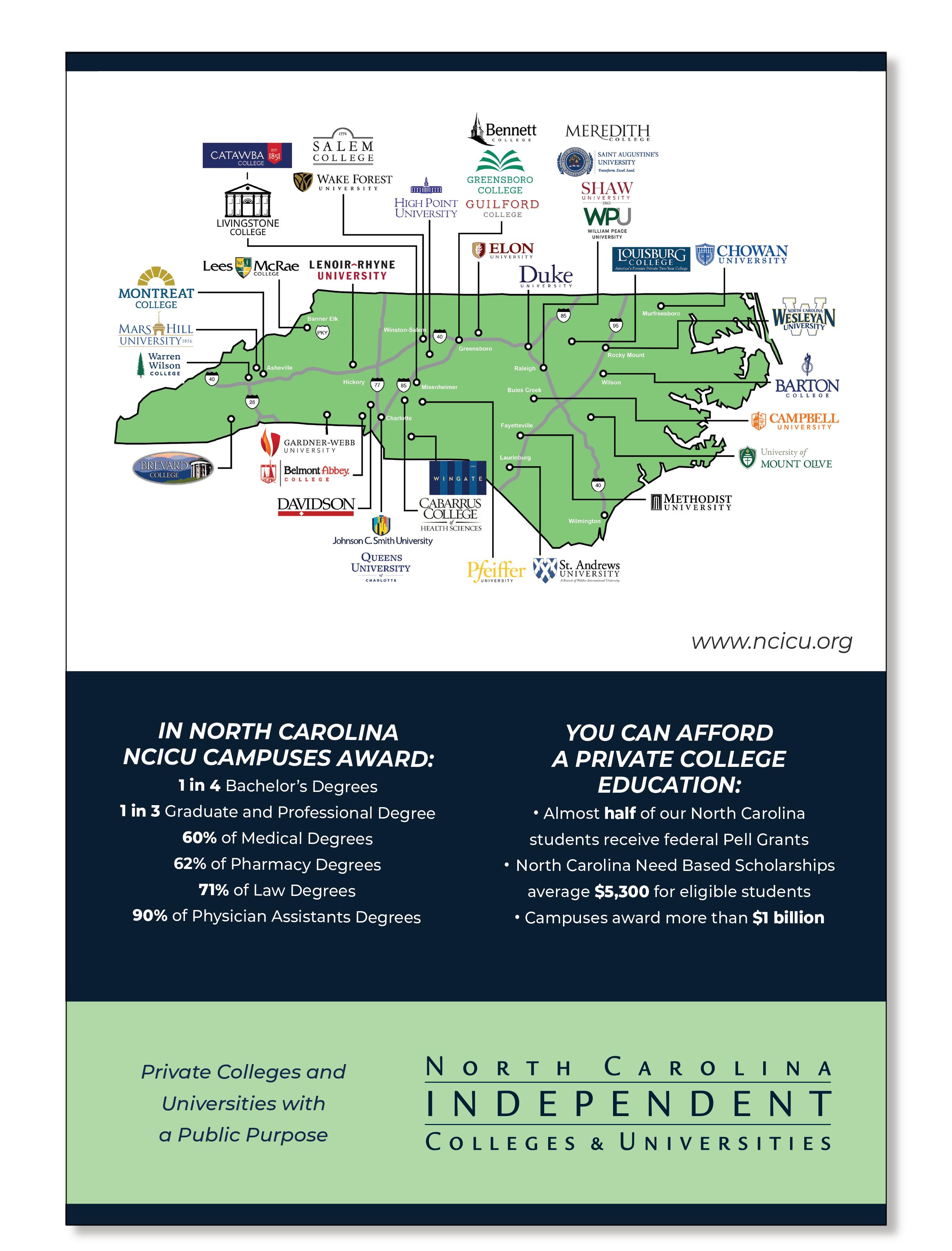
53 MAY 2023
MBA PROGRAMS 2023
COLLEGE OR UNIVERSITY SCHOOL
APPALACHIAN STATE UNIVERSITY* Walker College of Business
BARTON COLLEGE School of Business
CAMPBELL UNIVERSITY† Lundy-Fetterman School of Business
CAROLINA UNIVERSITY Patterson School of Business
DEAN/DIRECTOR LOCATION
WEBSITE
Sandra Vannoy Boone, online business.appstate.edu
Ronald E. Eggers Wilson barton.edu/graduate/master-of-businessadministration/
Kevin O’Mara Buies Creek, Raleigh, online business.campbell.edu
Alma Gracic Winston-Salem, online business.carolinau.edu/
DEVRY UNIVERSITY† Keller Graduate School of Management Charlotte, online devry.edu/online-programs/mastersdegrees/mba.html
DUKE UNIVERSITY* Fuqua School of Business
EAST CAROLINA UNIVERSITY* College of Business
ELON UNIVERSITY* Martha & Spencer Love School of Business
FAYETTEVILLE STATE UNIVERSITY* Broadwell College of Business and Economics
GARDNER-WEBB UNIVERSITY† Godbold School of Business
HIGH POINT UNIVERSITY
LENOIR-RHYNE UNIVERSITY†
Earl N. Phillips School of Business
Charles M. Snipes School of Business & Economics
MEREDITH COLLEGE* School of Business
MONTREAT COLLEGE School of Adult & Graduate Studies
N.C. A&T STATE UNIVERSITY* Wille A. Deese College of Business and Economics
N.C. CENTRAL UNIVERSITY* School of Business
N.C. STATE UNIVERSITY* Jenkins Graduate School/Poole College of Management
NORTHEASTERN UNIVERSITY
PFEIFFER UNIVERSITY†
D’Amore-McKim School of Business
QUEENS UNIVERSITY* McColl School of Business
ST. ANDREWS UNIVERSITY
Bill Boulding Durham, global locations fuqua.duke.edu
Michael Harris Greenville, online business.ecu.edu
Raghu Tadepalli Elon, Research Triangle Park elon.edu/u/academics/business/
Ulysses Taylor Fayetteville, online uncfsu.edu
Mischia A. Taylor Boiling Springs, Charlotte, online gardner-webb.edu/programs/businessadministration-mba/
Daniel Hall High Point, online highpoint.edu/graduate/mba
Craig Schreiber Asheville, Hickory, online lr.edu/business-administration-mba
Kimberly Burke Raleigh meredith.edu/mba
Paul Gratton Asheville, Charlotte, online montreat.edu/mba
Kevin James Greensboro, online ncat.edu/cobe/mba/index.php
Anthony C. Nelson Durham, online nccu.edu/business
Frank A. Buckless Raleigh, RTP, online mba.ncsu.edu
Emery Trahan Charlotte, online northeastern.edu/charlotte
Susan Luck Charlotte, online pfeiffer.edu/mba
Greg Pillar Charlotte, online queens.edu/mba
Wayne Freeman Online sa.edu/master-of-business-administration/
STRAYER UNIVERSITY† Charlotte, Greensboro, Morrisville, Raleigh strayer.edu
UNC CHAPEL HILL* Kenan-Flagler Business School
UNC CHARLOTTE* Belk College of Business
Jennifer Conrad Chapel Hill, Charlotte, online kenan-flagler.unc.edu
Jennifer L. Troyer Charlotte, online mba.uncc.edu
UNC GREENSBORO* Bryan School of Business and Economics McRae Banks Greensboro, online bryan.uncg.edu
UNC PEMBROKE* Thomas School of Business
UNC WILMINGTON* Cameron School of Business
UNIVERSITY OF MOUNT OLIVE
Robert L. Tillman School of Business
WAKE FOREST UNIVERSITY* School of Business
WESTERN CAROLINA UNIVERSITY* College of Business
WINGATE UNIVERSITY Porter B. Byrum School of Business
WINSTON-SALEM STATE UNIVERSITY School of Business
Mohamed Djerdjouri Online uncp.edu/mba
Robert Burrus Online csb.uncw.edu/grad/index.html
Kathy T. Best Online umo.edu/mba
Michelle Roehm Charlotte, Winston-Salem , online business.wfu.edu/mba
Angela “AJ” Grube Asheville, online wcu.edu
Sergio Castello Charlotte
Manju Bhat Online
wingate.edu/graduate-programs/master-ofbusiness-administration
wssu.edu/admissions/programs/businessadministration-mba/index.html
MBA PROGRAMS 2023 * accredited by the Association to Advance Collegiate Schools of Business † accredited by the Accreditation Council for Business Schools and Programs 54 BUSINESS NORTH CAROLINA

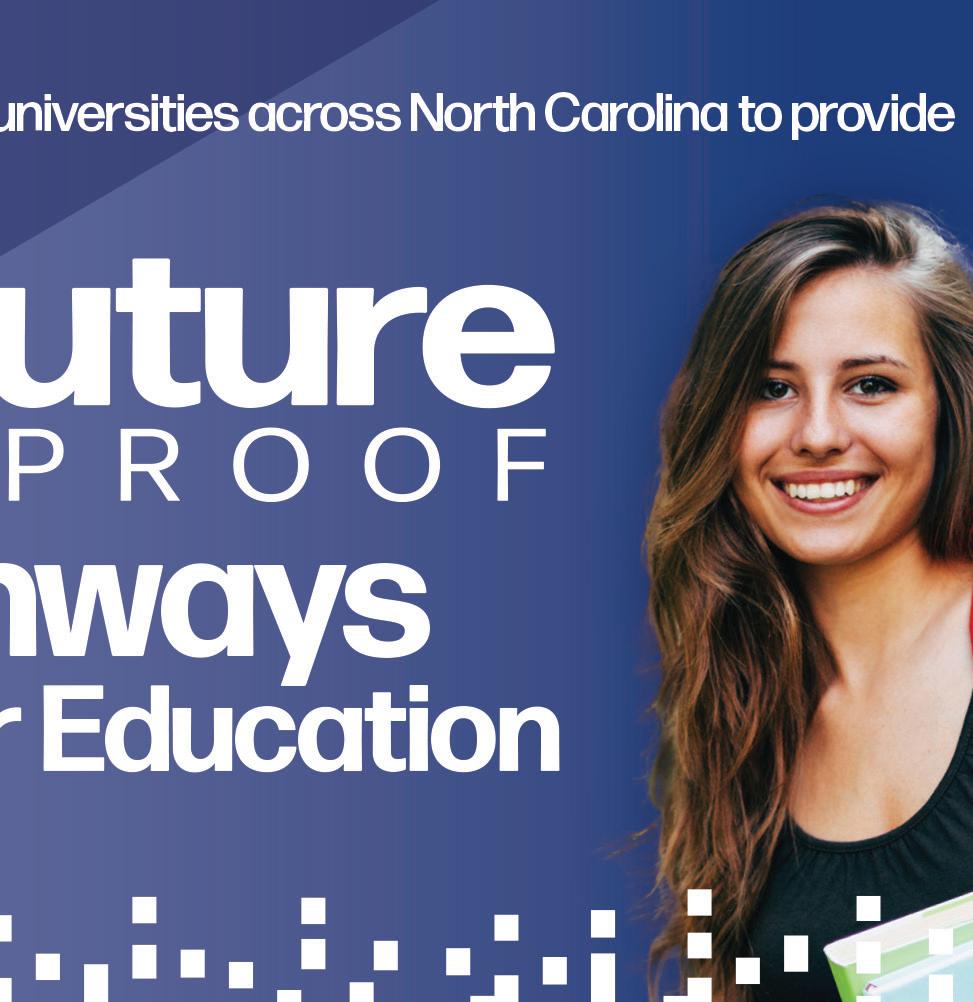


55 MAY 2023
PRUNING TIME
Fintech innovator LendingTree recharges after rivals stole its thunder.
 By Mike MacMillan
By Mike MacMillan
Not long ago, the stars seemed to be aligning for LendingTree. The titanic shift to more online purchases of homes, cars and insurance policies would surely propel digital ad spending to benefit the business that CEO Doug Lebda had built with tenacity since 1996.
By 2017, after years of marketing spending topping $2 billion, LendingTree’s “When banks compete, you win” tagline was part of the online financial marketplace’s lexicon. LendingTree’s brand awareness ranked at 69% among consumers, not far behind Chase’s 77%, and dwarfed other financial services startups such as Zillow, Rocket Mortgage and Bankrate, company research showed.
Investors bought the story, pushing the market value of the Charlotte-based financial services platform company to as much as $5 billion in mid-2019. Four years later, the shift online in financial services continues at a rapid clip, but the shiny promise of LendingTree has lost some luster.
56 BUSINESS NORTH CAROLINA
It has laid off about a fifth of its staff in the past year. Revenue tripled between 2016 and 2019, but has flatlined since then. Including charge-offs, the company has reported a cumulative $150 million net loss over the last four years. The market cap was about $300 million in mid-April.
LendingTree’s history is that of a survivor, however. Lebda, a former Ironman competitor, has shown remarkable staying power. The company is buckling down and testing new strategies. The company last year hired “Saturday Night Live” personality Molly Shannon to front a marketing campaign in support of its newest product, the Win Card. She will appear in some new ads this year.
Win Card is LendingTree’s first branded credit card. The goal is to encourage a deeper relationship between customers and the company by rewarding responsible borrowing with benefits linked to the card. For example, a 20-point increase in one’s credit score prompts an automatic increase in the borrowing limit.
Initial offers went to members of MyLendingTree, an opt-in service that provides free credit scores and credit monitoring to about 25 million people. Membership in the service has more than doubled in the past five years. “It’s our version of Amazon Prime,“ Lebda says.
“We want to be a digital ally to the consumer,” says J.D. Moriarty, the company’s president of marketplace and chief operating officer. “Win Card is the start of that.”
The launch follows a challenging year for consumer lenders and people trying to buy homes, cars and insurance. Rising interest rates spiked mortgage originations, and put a damper on refinancings, both big businesses for LendingTree. Insurance, another big line, was hit by inflation as rising prices for used cars and car repairs caused insurers to pull back. The cost of personal loans rose. “Our business was tested in 2022, in perhaps one of the most difficult operating environments we have faced in our history as a public company,” according to LendingTree’s year-end letter to shareholders.
In 2022, the company reported a
loss from continuing operations of $188 million, or $14.69 per share. That followed a $69 million profit a year earlier, or $5.34 per share. LendingTree revenue fell to $984 million, compared with $1.1 billion in 2021.
Once heavily dependent on revenue from mortgage products, LendingTree has diversified effectively in the past decade. The company’s biggest business segment, consumer, which includes credit cards and personal loans, saw 2022 revenue increase by 20% to $396 million. But the home unit, which includes the mortgage products, was down 34%, to $289 million. Insurance, the third major category, dipped 8% to $299 million.

Much has been beyond LendingTree’s control. In March 2022, the Federal Reserve began to lift interest rates at the fastest pace in decades. By the end of the year, the cost of borrowing from the Fed had jumped from effectively zero to about 4.5% and 30-year, fixedrate mortgages were costing nearly 7%.
LONG HAUL
A defining quality of LendingTree is its longevity. Founded as Lewisburg Ventures with $3,000 in 1996 by Doug Lebda, Tara Garrity, and Jamey Bennet, the company became CreditSource and then LendingTree. Lebda, who grew up in Lewisburg, Pennsylvania, dropped out of the University of Virginia’s MBA program to build the company. It went public in February 2000, a year best remembered for the dot-com crash.
Hundreds of early stage companies vanished, but LendingTree survived and grew rapidly, which observers credit to more than $50 million in clever advertising in 2000 that directed consumers to mortgage lenders eager to make deals. Three years after the IPO, media executive Barry Diller’s IAC bought the company for $725 million, or about four times revenue. It wasn’t his finest deal. The financial crisis in 2007-2009 swamped the mortgage market, and IAC wrote off $475 million related to the acquisition.
IAC spun off LendingTree in 2008, marking its second incarnation as a public company. It was still led by Lebda. Shares
57 MAY 2023
PHOTO CREDIT: CATHY SWANEY
started trading for about $8, then flatlined for several years as the reliance on mortgage products declined from about 90% of revenue in 2013 to 45% in 2017. Adjusted operating earnings soared from $19 million in 2013 to $154 million in 2018, helping make LendingTree one of the hottest U.S. stocks during that period. Many investors thought that Lebda’s success in home lending channels could be replicated in other consumer franchises.
“LendingTree is the secret success story of fintech,” technology news site TechCrunch wrote in 2018. An investor presentation that year noted that the company was poised for the game-changing shift toward online shopping for financial products.
LendingTree wasn’t alone in noticing the trend, however. That included companies offering similar services with bigger financial backers and major ties to the Charlotte area. Credit Karma is owned by Intuit, whose brands include TurboTax and QuickBooks. Last year, it opened a south Charlotte office that employs more than 600 employees. Then there’s Bankrate, which was acquired for $1.7 billion in 2017 by Red Ventures, the Fort Mill, S.C.-based company with estimated annual revenue of $2 billion, according to a New York Times story in 2021.
Meanwhile, online marketplaces were evolving from transactiondriven matching services to being increasingly anchored by data and personalized recommendations. LendingTree’s innovation was encouraging customers to submit a loan application, then get five competitive offers. It was Lebda’s creative response to his own frustrating effort to secure his first home loan while living in Pennsylvania. The problem is that the conversion rate — the percentage of loan or credit card applications ultimately approved by a lender — is consistently low.
Those five competitive lenders each paid LendingTree about $30 to show their offer to a customer, says Robert Wildhack, an analyst at Autonomous Research in New York. “But you only click on one so that for four of them, that’s $30 they’ve basically flushed. Better recommendations make the consumer happy and they make the lenders happy because they lead to higher conversions so they (the
lenders) will pay more.”
The conversion rate issue has been a particular problem for LendingTree’s credit card business. Given the environment, Wildhack says, the company has “done a pretty good job re-emphasizing its home equity and purchase businesses. Personal loans, too.” But credit cards are different. “Credit cards are where the competitive pressures are showing through.”
Rival Nerdwallet, a publicly traded San Francisco-based company, has had double-digit growth in its card business, while LendingTree shows double-digit declines, the analyst says. To address this, the company rolled out an automated pre-approval platform last year dubbed “TreeQual.” It collects more customer data upfront, allows for better targeting and, ultimately, higher approval rates.
When LendingTree redirects a consumer to a partner’s website for credit cards, fewer than 15% of applications are approved, according to Moriarty. “When we’re talking about something that is pre-approved, it is converting at an 80% approval rate,” he says. Through TreeQual and MyLendingTree, the company can compare consumer credit accounts against offers on its network, and contact customers when there is an opportunity to save money.
“With MyLendingTree, the consumer proposition is giving you the right answer, not necessarily a multiple choice,” Lebda says.
CREDIT SCORE KARMA
LendingTree is also addressing the cost of acquiring customers. It relies heavily on paid search to bring customers to its platform. Those customers are then connected to a network of more than 600 lenders, insurers, and credit card issuers.
Those ads are costly, with the company’s total marketing expense typically making up more than half of revenue. The trends on marketing spending have been moving in the wrong direction, pressuring LendingTree’s margins. In the fourth quarter of 2022, it spent $124 million in advertising to generate its $202 million in revenue. The previous year, the company spent $170 million in that period, resulting in $258 million in revenue.

58 BUSINESS NORTH CAROLINA
LendingTree moved its headquarters from south Charlotte to the South End neighborhood last year.
PHOTO CREDIT: KEVIN ELLIS
LendingTree’s competitors are viewed as less dependent on paid advertising, relying instead on search engine optimization (SEO) and other lower-cost strategies to attract clients to their websites.
“NerdWallet and Credit Karma were the rst to gure out that advertising free credit scores was a great way to attract users,” says Lebda. LendingTree provided free credit scores, too, but did not market the service as aggressively.
“( eir) volume has been built up with SEO and content. ey’re not dependent on advertising to the tune of 65% of revenue. ey’re getting their tra c from Google organic search as opposed to Google paid search.”
A Google search for “personal loan rates” brings up a screen with LendingTree at the top, followed by a website called 10bestpersonalloans.com, and then NerdWallet. LendingTree and the 10best site are agged as “Sponsored,” meaning they have paid for their place in the listings. NerdWallet appears organically, based on content it has generated that has been optimized for the search engine terms utilized by Google’s algorithms.
“We’re playing a catch-up game in SEO,” Lebda says. “It’s one of the major initiatives we’re working on.” To improve its search-engine results, LendingTree has hired editors, writers, and researchers and technical experts to put together a library of personal nance content.
A CYCLICAL BUSINESS
More than a decade of near-zero interest rates has created obvious distortions in the economy, including favorable ones such as ultra-low rates for mortgages and lines of credit. at era has come to a close, particularly a er the Silicon Valley Bank failure in March exposed banking industry problems caused by the sharp uptick in rates. Still, most economists concur that Fed tightening should be ending by early next year, and markets are adjusting
People still need a place to live, which will require mortgages. Some who have equity in their homes will want to borrow to help pay for cars, which will need insurance. ey will also take out personal loans.
LendingTree’s core businesses are not going away. Companies that are successful in streamlining the application and approval process and
increasing the relevance of products will have a competitive advantage.
LendingTree expects to remain a viable competitor with Lebda, 53, having obvious motivation to excel. He’s the company’s largest shareholder with 2.17 million shares as of April 2022, or about 17% of outstanding shares. BlackRock also owned about 17%, while Vanguard held nearly 10%.
His base salary of $750,000 has been supplemented historically by large stock option awards, including about $33 million provided in December 2020. ose options have an exercise price of $300 that expires in 2030, putting them far out of the money given the sharp decline in LendingTree’s shares. During more successful years, Lebda cashed in on tens of millions of dollars of stock options, helping pay for a minority stake in the NFL’s Pittsburgh Steelers, start a foundation and become a Charlotte civic leader.

Analyst views on LendingTree are generally positive. As of April, nine of 10 of analysts tracked by Yahoo Finance had a “buy” on the company, with an average price target of about $40. ree rated the stock a “hold” and one an outright “sell.” For now, LendingTree is trimming costs and investing selectively. e company dismissed about 150 workers this spring, following 200 job cuts last year. Before those actions, the company had said it employed about 1,350 people. In June, it is closing the Ovation Credit Services credit-repair service it bought for $20 million in 2018, the Jacksonville Business Journal reported.
Revenues for this year are expected to be roughly at compared to 2022 with its home unit down by at least 20%. e consumer and insurance businesses are projected to expand at mid-single digit rates.
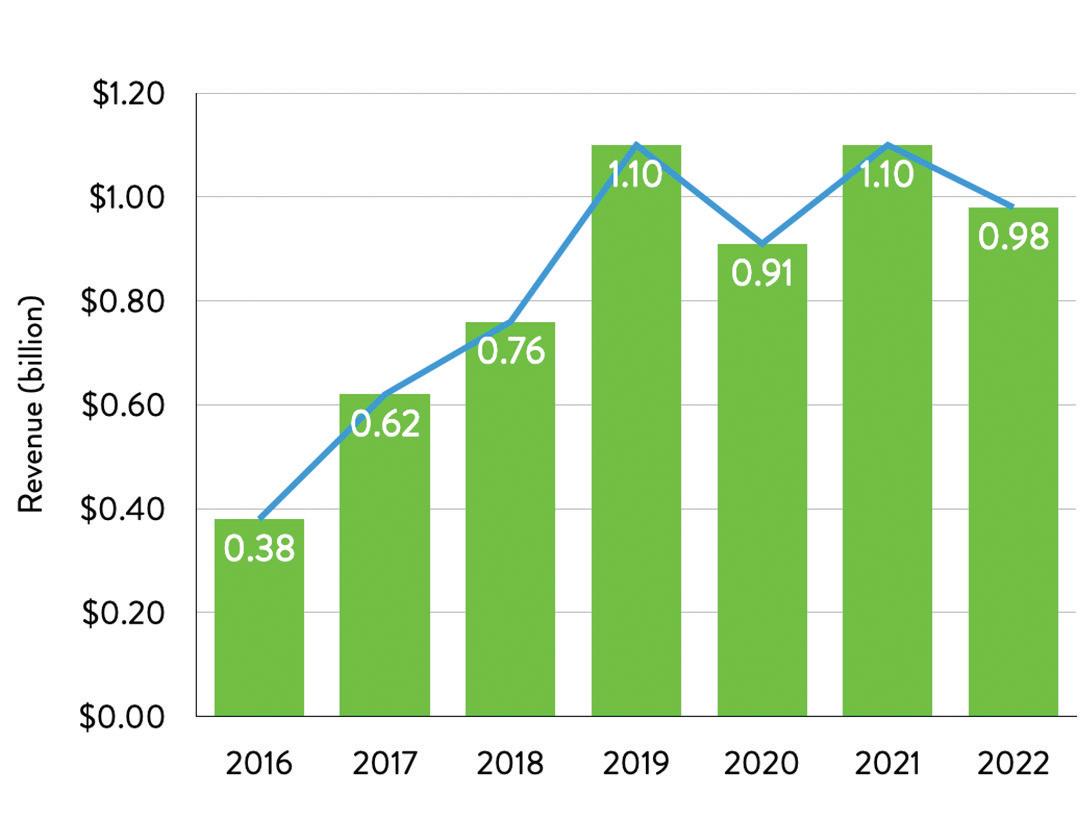
Fortunately, LendingTree’s balance street remains “a source of strength” because it didn't overpay for acquisitions in recent years when valuations were high, Lebda wrote in his shareholders letter. Cost of servicing its $824 million in debt is less than 3%, while the company earns more than 4% on its $299 million cash balance.
e work continues, Lebda says, to “build a destination for our customers to get timely advice on how to improve their nancial lives, which is more relevant to them now than ever." Or as Molly Shannon might say, "Ya need a lenda?"■
59 MAY 2023
LendingTree revenue (billion)
Source: LendingTree
27 15 96 18 -48 -187 69
LendingTree net income (million)
DO IT YOURSELF

North Carolina’s subculture of tinkerers, hobbyists and DIY enthusiasts finds a home in nonprofit makerspaces.
By Shannon Cuthrell
A 3D-printed prosthetic hand, a light-up hula hoop, a breathing treatment device, brewery tap handles, embroidery display frames and resin pours amassing 2.5 million TikTok followers — these are some of the products of North Carolina’s makerspace scene.

e concept of makerspaces — also known as “hackerspaces” — isn’t exactly new, historically applied in public libraries or universities. In recent years, dedicated hubs for do-it-yourself enthusiasts and artists have popped up nationwide, o en operating as volunteer-run nonpro ts relying on member dues, grants and corporate sponsorships. North Carolina’s makerspaces are lined with laser cutters, 3D printers, pottery and ber arts studios — resources that would cost thousands of dollars to purchase.
More important than fancy equipment, makerspace leaders say, is the diversity in backgrounds their makers bring to the dynamic. “Someone who does a ber cra like knitting and someone who does electronics probably don’t understand each other’s cra s, but if you get them talking they’ll always nd some way to relate,” says Zak Smolen, president of Asheville Makers, a 950-square-foot downtown-area spot where 25 members pay $50 monthly to use the space and tools.
60 BUSINESS NORTH CAROLINA
A few years ago Smolen wanted to 3D-model an engagement ring, but had a shortfall in experience. Another member needed di erent help for their project. “We both traded knowledge, him helping me with 3D design and me helping him with electrical circuit design, and together both learned new skills from the experience and completed our projects,” says Smolen.
Camaraderie among makers strengthens the whole. While de nitions vary on what being “a maker” means, North Carolina’s makerspaces say the mindset of their diverse and interdisciplinary crowd de nes them better than a formal title.
“We o en see collaborations among people that wouldn’t have met outside of the makerspace,” says Elaine Lamson, executive director of Winston-Salem’s 7,200-square-foot Mixxer Community Makerspace. Since opening in 2018, the makerspace has attracted 177 members and 2,500-plus people who create items from art to furniture, jewelry to complex machines.
“Some create for personal use, some for pro t, as a learning exercise or simply a creative outlet,” says Lamson. “ e thing all of those makers have in common is a need for support. at support is what makers o en need to be successful, and is central to the service Mixxer provides.”
Countless members of North Carolina makerspaces have become small businesses, including more than 20 entrepreneurs who have started a business idea at Mixxer. Others have created nearly a dozen public art installations. Some have participated in entrepreneurial programs at Winston-Salem’s Center for Creative Economy and the Flywheel coworking and innovation group. Smoodi, which relocated
from Boston to the Triad, maintains its eet of self-service smoothie machines at Mixxer.
In the pandemic, Wake Forest Innovations engineers used Mixxer’s laser cutter to prototype personal protection equipment for medical procedures. And team of six, comprising a doctor and members experienced in fabrication and electronics, collaborated on a breathing treatment device.
DIY LE EXPENSIVE
Access to tools draws makers in, and organizers factor members’ needs into their budgets, which range from $25,000 at Asheville Makers to $500,000 at spaces in Winston-Salem and Greensboro.


Durham’s 2,600-square-foot Splat Space ensures its 70 members have the tools required for whatever project they’re working on.

“A number of our members don’t have the space at home to own a large array of tools or even to work on projects,” says Splat Space board President Blake McNeill, a database engineer at Morrisvillebased e-commerce rm ChannelAdvisor. “When we consider how to use our budget, we prioritize adding value for our members with resources and equipment that are too large, expensive or complex for most people to have at home.”
Full membership at Splat Space costs $60 per month, with discounts for students. Re ecting the underlying life science- and technology-rich economy of the Research Triangle Park region, three groups in Splat Space are working on projects for startups in electronics and biotechnology.
61 MAY 2023
PHOTO COURTESY OF FORGE GREENSBORO
Forge Greensboro offers tools and space for people to create a wide variety of products.
SMA BUSINE START





e Triad’s 270-member Forge Greensboro expanded in 2021 to ll the entire building at West Lewis Street, adding around 3,000 square feet to sublet private workspaces and a modular classroom primarily for youth programming. at expansion is home to an incubator-style program called Maker Studios.


e rst tenant was 3D Up tters, started years ago when entrepreneur Michael Czeiszperger joined the Forge and prototyped an enclosure to improve air and print quality in 3D printers. He found employees there trained in manufacturing equipment and ran pressure tests on the heavily-used 3D printers. Czeiszperger eventually sublet 450 square feet, moving logistics, storage and design out of his home. 3D Up tters then grew its monthly sales and secured its own equipment and production facility once its year-long lease ended.
MakerSpace Charlotte, too, has seen plenty of inventions spin into larger projects. At 21,000 square feet with 350 members, it’s one of the state’s largest makerspaces. Executive Director Steven Gray says about a dozen businesses rent studio space, with another 20 using the space to supplement their other operations.






One can get a 10-by-10 studio for $300 per month or a 5-by-10 option for $175, along with access to MakerSpace Charlotte’s equipment stockpile. is price point appeals to entrepreneurs who want to dip their toes into their venture before committing.








“O entimes it takes an entrepreneur two or three failed attempts at a business before they nally nd a formula that works,” Gray says. “With our very low cost of entry, more people can a ord to take the third bite of the apple.”

62
BUSINESS NORTH CAROLINA North
@forgegreensboro @splatspace @mixxercommunitymakerspace @makerspacecharlotte @forgegreensboro @forgegreensboro @splatspace
Carolina makerspace projects and posts on Instagram.
VARIED BUSINE MODELS
Makerspaces are similar to the coworking space concept, but with more varied, niche business models. Some are backed by grants: Several organizations support Forge Greensboro with at least $10,000 each via sponsorship or grant funding, including Lincoln Financial Foundation and Triad-based Cemala Foundation, TannenbaumSternberger Foundation, legal-services technology rm TCDI and o ce rental agency AZ Development. It recently added the National Science Foundation and Greensboro-based website designer Zibster as sponsors.

Mixxer likens its business model to a YMCA membership, paired with classes and summer youth programs. About 60% of its income comes from class revenue and membership fees, at $65 per month for individuals, $99 for families and $45 for students. e rest is from individual donors and grants through the WinstonSalem Foundation, the Arts Council of Winston-Salem and Forsyth County, Duke Energy Foundation, Piedmont Federal Savings Bank, Corning Incorporated Foundation and others.
MakerSpace Charlotte has yet to receive any grant funding. “We don't want to be dependent upon grants to keep the lights on, hence our focus on being self-sustaining,” says Gray. “We’ve heard horror stories about nonpro ts that didn’t have their grants renewed.” MakerSpace Charlotte has an annual income of about $275,000 a year, mostly from $50 monthly member dues and studio space rentals.
Volunteer sta ng helps some makerspaces keep costs low for members, and some have struck favorable deals with their landlords. Avi Silverman, of Asheville Makers, was around when it started in 2013 as a social group that would meet at a pizza place and “nerd out” about projects. Since then, it has moved twice with its landlords allowing the group to avoid raising a large amount of capital. e rent payment model at its rst building was pay-whatyou-can, allowing Asheville Makers to gain interest and members without worrying about short-term survival. “We were then able to work out a deal with our current landlord who allowed us to start paying at half-rent and ramp up payments over our rst six months of occupancy, giving us enough time to grow our membership to keep up,” Silverman said.
Finding space to accommodate growth remains a challenge. Splat Space formed a members' committee to scout locations larger than its current digs in the Old Five Points area near downtown Durham.
“We’re seeing old buildings being torn down and townhomes and apartments being put into their place at an astounding rate,” McNeill says. “Our location will not be immune to this change, and we believe that needing to move due to redevelopment is a question of when, not if.”
MakerSpace Charlotte’s biggest challenge is nding its next space, as its lease nears an end in mid-2024. Its current rate is likely to double from the contract signed in 2019. Gray fears being stuck in a small space for several years because of costs. “We’ve been fortunate to nd lease situations that allowed us to grow in physical size as our income increased,” he says. “With the run-up in real estate prices in Charlotte and the concomitant increase in lease rates, it may be very challenging to nd a situation where we can repeat the ‘lease more than we can a ord and then expand’ combo.”
IMPRE ING OUTSIDERS




Perhaps an unexpected economic impact is that makerspaces can be uno cial site-selection testaments to outside businesses looking to relocate to North Carolina. About a dozen times over the past year, Gray has seen visitors considering moving to Charlotte cite the makerspace’s o erings as a signi cant deciding factor. Splat Space has also been contacted several times by out-of-state startups interested in having their sta use its facilities.
“We take this as a sign that we and the broader network of makerspaces are increasing in importance as a direct resource for day-to-day operations of young companies as they consider moving to North Carolina, on top of the work we already do to build up the underlying tech community here,” McNeill says.








O setting the usual pro t motive characterized by real estate landlords, nonpro t makerspaces have room to pursue dreams at a more sustainable timetable. For MakerSpace Charlotte, that means establishing a “demo” to build credibility as a cultural hub. In orientations, Gray tells people he’s working to combine three ideas: e shared tools and community of a makerspace with Burning Man’s human creativity and Disney’s curb appeal.
“It’s kind of ridiculous, I know, but I want the makerspace to be the cultural destination in Charlotte. We’re not there yet, but that’s the larger goal,” he says. “If you get the artist, you get everything else. We want to be a place where artists say, ‘of all the places I can go to set up shop in Charlotte, I want to be at the makerspace.’” ■
63 MAY 2023
@splatspace @mixxercommunitymakerspace @mixxercommunitymakerspace @makerspacecharlotte
UNION COUNTY IS KICKING
Union County’s growth and success is occurring across the board in manufacturing, aerospace, agriculture, infrastructure and education. The county southeast of Charlotte that shares a southern border with South Carolina has much to offer businesses and residents.
A total of 195 manufacturing firms, including 16 international companies, collectively employ 14,800 people. Aerospace companies account for 4,500 jobs. The Charlotte-Monroe Executive Airport is updating its runways along with adding hangar space to accommodate an increasing number of corporate jets.
The city of Monroe’s new 155-acre Expressway Commerce Park is its third industrial park and a crucial addition since Monroe Corporate Center and AeroPointe Industrial Centre are nearly full.
As the state’s third-largest agricultural producer, Union County has 957 farms covering 186,626 acres. It ranked No. 2 in the state’s soybean production in 2021 and No. 1 in wheat production in 2020.
EARLY CAREER EXPLORATION AND FLEXIBLE EDUCATION
This extensive variety of commerce gives students in Union County’s 13 high schools many choices for jobs and careers.
Union County is pioneering ways for high school graduates to achieve a free college education tailored to negate scheduling conflicts with jobs or personal responsibilities. Students wishing to add job training courses compatible with current employment have education options designed to be flexible at South Piedmont Community College, with campuses in Union and Anson counties, and Wingate University’s locations in Wingate, Charlotte and Hendersonville
“In the almost 10 years I’ve been on staff at the Chamber, we have worked with our education, workforce development and business partners to collaborate on retaining, recruiting and

SPONSORED SECTION COMMUNITY CLOSE-UP UNION COUNTY 64 BUSINESS NORTH CAROLINA
PHOTO COURTESY OF SOUTH
New education programs and changes in agriculture and air travel are making big impacts.
PIEDMONT COMMUNITY COLLEGE
developing a talent pipeline to serve the needs of our business community,” says Union County Chamber of Commerce President and CEO Pat Kahle. “The Chamber’s role is to convene these partners to discuss ways to meet the challenges, leverage the opportunities and develop programs to do both. We’ve learned over that time that workforce development begins at birth and extends through retirement.”
This philosophy is pervasive.
“So many times students would have to choose between work, their families and education, and we try to make it so they don’t have to make that choice,” says Carl Bishop, SPCC’s vice president for academic affairs. “We rebuilt almost 500 courses in our catalog to reflect flexibility. When life happens, they no longer have to make choices. They can be in person this week, online the next.”
A program known as HyFlex Classroom Technology is one of several higher-education innovations and has drawn interest from other cities and colleges in the state, Bishop says.


“It’s a conversation happening within the community college system. We started offering it before the system was set up for it, so we’ve been in touch with others at the regional and state levels about how to replicate it.
“People don’t have to fit their lives into college; they can fit college into their lives. The phrase ‘Are students ready for college?’ has become ‘Are we ready for our students?’”
Union’s healthcare and farming/ agriculture segments are committed to the process.
Agriculture education is available as early as elementary school, with classroom presentations from Cooperative Extension personnel. Atrium Health, Union’s Health Sciences Academy, introduces elementary students to the health field.
“This continues throughout middle school and high school. In this program, students see the opportunity for their own economic growth through career

training and, eventually, employment,” says Denise White, Atrium Health Union’s vice president, facility executive and chief nursing executive. “Atrium Health is seeing value by investing in these students as we continue to think of innovative ways to increase the healthcare workforce pipeline, for physicians and nurses, as well as all areas of the workforce.”
Exposing students early and continually to career options where they live is key.
“The work in the school system that we’re doing to help the next generation is vital because that’s where change really happens,” says county Extension Director Andrew Baucom. “They are the ones who will be making decisions moving forward. Every high school in Union County has an agricultural program, and we have two in the middle schools, with the goal to add
more in order to generate that workforce development and interest in our youth early on.
“Union County Schools also have created agricultural technology programs that are taught in elementary schools, which feed into middle and high schools, which they can continue to a community college or four-year university.”
The Chamber is also reaching out to students long before they are close to graduating high school.
“The Chamber’s Workforce Development Task Force is focused on partnering with Union County Public Schools as early as middle school to help students with career exploration before they make critical decisions about high school classes,” Kahle says. “The Chamber’s Middle School Speakers Bureau partners with two different middle
65 MAY 2023
PHOTOS COURTESY OF SOUTH PIEDMONT COMMUNITY COLLEGE AND ANESU SIMANGO FROM WINGATE UNIVERSITY
Carl Bishop, top left, heads academic affairs at South Piedmont Community College. Wingate University's Wayfind Scholars mentoring program draws praise from local officials.
schools each year and sends business and industry representatives into the schools to ‘take over’ a classroom for the day six times during the year. The speakers complete a training session to help them effectively focus on essential soft skills, career progression and hands-on activities that help the students better understand the company and industry.”
SPCC creates courses and degrees that meet the needs of local employers.
“We understand at South Piedmont that a huge part of our mission is driven by workforce,” Bishop says. “Even with our transfer programs, we try to align with the workforce because, at the end of the day, when a student goes for a four-year degree, when they come out they want jobs. So we try to promote economic growth.”
So does Atrium Health Union.
“Atrium Health’s partnerships with Union County Public Schools, South Piedmont Community College and Wingate University are designed to benefit everyone,” White says. “We all have a vested interest in ensuring that all students are afforded the best opportunities for learning and career development, regardless of their economic status.
“The partnerships with South Piedmont Community College and Wingate University continue the education and employment pipeline for students seeking degree-required careers. After completion of a degree, students have an even greater opportunity for breaking the economic mobility barriers that threaten some underserved and underrepresented communities by becoming Atrium Health teammates.”
EDUCATION PAST HIGH SCHOOL FOR EVERYONE
Wingate University has invested more than $2.5 million in Wayfind, a mentorship program that begins in eighth grade and prioritizes students who are historically underrepresented, such as students of color who could be the first in their family to seek education past high school, according to the university website. The high school class of 2023, the program’s first graduating class, includes a student wanting to be a social worker, another with plans to be a police officer and another whose goal is to be a therapist.
The mentorship program selects 10 students from Monroe Middle School and 10 from East Union Middle School. The process includes the opportunity to graduate from college debt-free.
“The partnership between Union County Public Schools and Wingate University is truly unique. I am not aware of any other partnership between a public school district and independent university that offers college access programming and full-tuition scholarships to deserving students,” says Abby Holland, director of Wayfind and a Wingate assistant professor. “While the aim of the program is to prepare students to be successful in college, it’s important to me that scholars feel a sense of belonging in the Wayfind community. One benefit to Wayfind Scholars transitioning to Wingate is already having a community and knowing individuals who can advise them formally and informally. Wayfind Scholars who attend Wingate will also have the opportunity to give back by being a mentor to middle and high school students.”
She says seven Wayfind scholars graduate this year from Monroe High School and three from Forest Hills High School. All have applied to Wingate and all but one have committed to full-time enrollment in the fall. “Students apply to
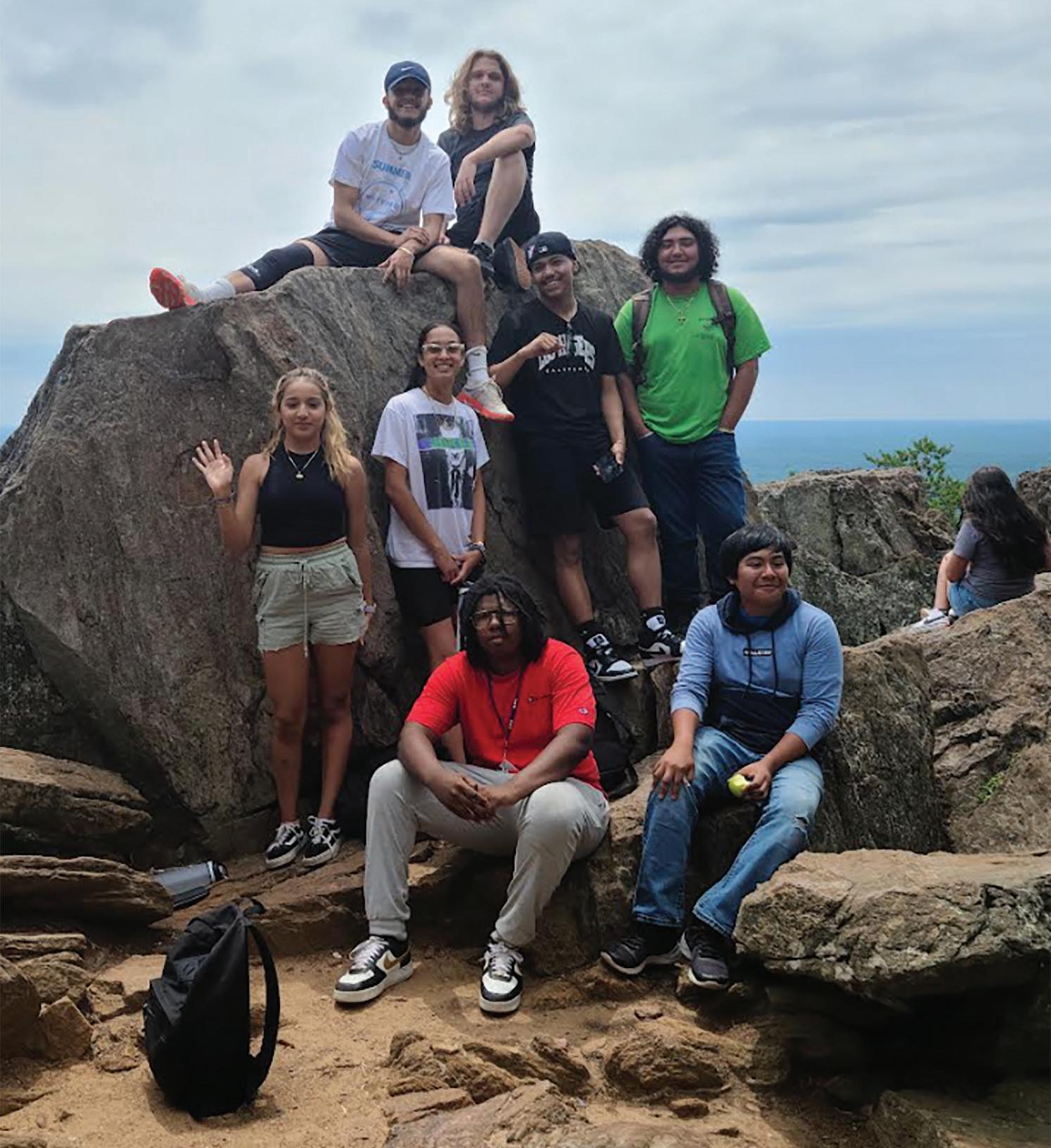
SPONSORED SECTION COMMUNITY CLOSE-UP UNION COUNTY 66 BUSINESS NORTH CAROLINA
PHOTO COURTESY OF WINGATE UNIVERSITY
Wingate's Wayfind Scholars are mentored starting in the eighth grade.
Wayfind in the fall of eighth grade. The selection committee announces who has been accepted soon after students return from winter break, and mentoring begins a few weeks later. When scholars enter ninth grade, they must maintain at least a B average and meet standards for school attendance and discipline.”
The program began in 2018. There are 80 Wayfind scholars in grades eight through 12.
SPCC, with an enrollment of about 7,500 students, has several academic routes. In February it was named a Best in Showcase winner and national top 10 finalist at the Bellwether Awards in San Antonio in the Instructional Programs and Services category for Learning Reimagined and its HyFlex concept.
“It’s about reducing barriers so we close the education-attainment gap by identifying the top barriers for our students, which are finances, employment and work schedules, family obligations and access to online ability and the ability to perform in online classes,” Bishop says. “If we take the barriers out of the way, students will access education and impact the workforce for area employers.”
Learning Reimagined is patterned after British company BibliU, an EdTech universal learning enablement platform used by 114 institutions worldwide, according to its website. The concept helps reduce costs and add flexibility.
“Books can be expensive,” Bishop says, “so we partnered with that company to reduce textbook and resources fees to $60 per course. Depending on the content, some courses normally could be $1,000. There was a staggering number of students who could not afford that.”
“South Piedmont’s Career in a Year program provides adult students the opportunity to earn their degree in a shorter period of time,” says Kahle. “Certificates and diploma programs allow adult students to up their skills in a short period of time and increase their earning potential.” Career in a Year includes healthcare, truck driving,
welding, bookkeeping and office administration along with several other professions.
Another route at SPCC is ApprenticeshipIMPACT which, “provides students who are interested in workforcespecific programs the opportunity to work and learn while they are pursuing education,” Bishop says. “So there’s an incentive for employers to train them on the job and have more positive outcomes in recruitment and retention.
“For students, it’s attractive because they have a job. They also have a wage that is progressive, so they aren’t forced to choose between work and school. All of it is tuition-waived, so they don’t have to pay a thing.”
In health care, White says, possible careers include business, teaching, emergency medical services, physicians assistant, physical therapy and many non-medical employment opportunities. SPCC partners with Atrium Health and
"Union County offers the best of both worlds. It's business-friendly and companies thrive with our skilled workforce and close proximity to the Charlotte metropolitan area. What's just as important is that it's a spirited community where families choose to live for quality of life, low taxes, great schools, and more. We're proud of those attributes Union County is known for. We certainly welcome any opportunity for both employers and families to consider planting their future in Union County."
 – Brian Matthews, Union County manager
– Brian Matthews, Union County manager


67 MAY 2023
other medical providers throughout the county. This has all been made possible by thinking about what we can do to meet the students and their needs when they enter the workforce.”
“In five years,” Bishop says, “I hope to be able to say we have closed the education gap and have helped our business and industry partners. For our residents, it’s a project of upward mobility, and workforces need a solid talent strategy. Businesses that find our county attractive will want to know if there is a talent supply. We’re making contributions to closing the education gap and helping the workforce.”
AGRICULTURE
“One of the unfortunate misconceptions about agriculture is that it’s a simple occupation,” Baucom says. “But you can take predominately all the science, technology and math jobs you
can think of, put them all together, and you have an agriculture producer. At the end of the day, that ag person is a mathematician, an accountant, a teacher, and they do such a wide variety of things with the most technically advanced equipment outside of the military. It’s mind-blowing. These guys have to be computer coders. Farming is not one single person out riding on a tractor digging up dirt.”
Based on its population per square mile, Union [640 square miles] recently was reclassified as an urban county, according to the Department of Agriculture. Still, Baucom says, agriculture is the second-highest county employer, behind health care, and is the No.1 economic driver.
In addition to crops, the county is a major producer of livestock and poultry, as well as “green industry” products such as sod and turf farms, and tree
and perennial nurseries. A changing demographic, he says, shows more smallfarm operations — gardeners who sell directly to consumers, farmers markets, restaurants and online platforms such as Union County Food Hub, which connects local growers to businesses.

“That sector has grown 200% since 2015, so it really shows the up-andcoming version of what agriculture looks like,” Baucom says. “We have third-, fourth-, fifth-generation farmers in the industry, as well as new folks in their 20s and 30s, which speaks to the legacy and future of agriculture here as an economic driver.”
Wingate offers a biology degree with a concentration in agricultural food systems. It also is next-door neighbor to the future 3,000-square-foot, multiuse Building Agriculture Resources and Nutrition (BARN). Details will be presented to county commissioners soon.
“We have input from a lot of entities. The town of Wingate, the university, the board of directors for economic development and the Agricultural Advisory Council all are in support,” says Rachael Holzman, new opportunities manager for Monroe-Union County Economic Development. “We’re also working to secure private funding and grant funding. The first part will be funding for an architect and building plans.”
BARN, she says, will have a commercial food kitchen, access to food processing equipment, and help farmers with product shipment.
“Wingate can have students learn and work in the BARN,” she says. “Or, people can come work on their, say, catering and then they’ll say ‘Hey, business is booming; let’s open a restaurant,’ and the town of Wingate benefits from that.”
The facility will be near the eastern end of the Monroe Expressway. “The bypass has been great for industry… farmers are not working 9 to 5, and they need a place to get their trucks moving quickly.”
SPONSORED SECTION COMMUNITY CLOSE-UP UNION COUNTY 68 BUSINESS NORTH CAROLINA
Fresh, local produce is popular at South Piedmont Community College's farmers market.
PHOTO
COURTESY OF SOUTH PIEDMONT COMMUNITY COLLEGE
BARN “would be a primary educator, and the work being done in K–through –12 is a heavy push for agribusiness and the food system,” Holzman says. “Farming is an incredible profession, and it’s a lot of hard work. There’s so much more than riding on a tractor. So many kids have no idea; the grocery stores don’t just magically make food appear. What we can do here with economic development is we deal with everything after it comes out of the ground.”
AIRPORT GROWTH

The Monroe airport’s master plan, which is updated every 20 years, recently received a major overhaul.
“We just finished the plan and submitted it. It’s very important to the city of Monroe,” says airport manager Peter Cevallos. “Just like our highways are part of the state and national plan, our airports across the state and across the country are part of a state and national aviation plan. So this master plan is a roadmap at both

69 MAY 2023
COURTESY OF THE CITY OF
PHOTO
MONROE
the state and federal levels.”
The airport is a ‘non-commercial general aviation facility,’ meaning it caters to smaller planes. It’s also a U.S. Customs stop, and houses a large amount of private and corporate hangars. It’s a preferred location for corporate jets. And it has a flight school.


“So where are we today? We’re moving forward. Union County has gotten bigger, and more industries are being created and our airport is a reflection of that growth,” Cevallos says. “So with more companies coming out there and setting up shop, they use the corporate and charter operations. So we’ve seen an uptick in airport operations. We are now
averaging close to 200 operations a day.”
Two years ago, Cevallos had 110 private planes in hangars with a total value of $25 million, including a $10 million corporate jet. Those numbers are growing, he says, “because people use airplanes as a business tool. It’s a reflection of the area and the customers we have. So many people are buying airplanes and parking their planes. They’re either privately owned, or owned by their corporation and people fly to conduct their business, like a company rep going to see clients. The privately owned planes people use for instance to take to the beach. We’re getting more and more of that. There are planes out there as
inexpensive as $50,000, about likean SUV.”
With that demand comes the need for hangar space.
“I’m actually currently working on two hangars. I’m facilitating leases that have to be done through the city to lease the land to build the hangars,” Cevallos says. “And I’m working with another gentleman who wants to build more hangars to bring in more corporate jets.”
Corporations are switching to private aircraft, he says, “because what it costs a company to buy three commercial airline tickets to send their executives to a meeting is much more than booking a charter flight. And it’s not just business executives. I had a corporate jet land here recently with a construction crew in jeans carrying hard hats and tool boxes.”
In the future, Cevallos hopes to get a tower. Currently, flight plans are done through radio frequency.
“But that’s not an amendment to the airport; it would be part of the national plan. And it’s a structure within itself, so it wouldn’t be operated by the city of Monroe, but by the FAA,” he says, “so I have to request permission, and I’m in the process. It could take a year to approve it, then we have to get in the conversation about grants and funds from the city. It’s a process.”
His message: “We’re here, and we’re kicking. Come see us.” ■
SPONSORED SECTION COMMUNITY CLOSE-UP UNION COUNTY 70 BUSINESS NORTH CAROLINA
Kathy Blake is a writer from eastern North Carolina.
Charlotte Monroe Executive Airport is continually upgrading. PHOTOS COURTESY OF THE CITY OF MONROE


71 MAY 2023
HELPING HAND
 BY KEVIN ELLIS
BY KEVIN ELLIS




Anew program from the North Carolina Rural Center will put as much as $50 million in the hands of investors, who will in turn invest the capital into the state’s small businesses. In July, the state-supported Rural Center expects to announce which venture capital funds, limited partners and investors will be part of the program. ose companies must agree to match those funds on a 2-to-1 basis.
“ is program will actually bring $150 million into the North Carolina economy,” says Rodney Sampson, who oversees the federally funded N.C. Venture Capital Program for the center.

e program’s goal involves placing 53% of the money in the hands of entrepreneurs identi ed as “socially and economically disadvantaged” by the Department of Treasury. e federal government will allocate $32 million at rst, then add $28 million to the fund if the selected investors hit that mark of reaching people who have found it di cult to raise capital.
“Over the past 50 years or so, socially and economically disadvantaged individuals who start venture-backable companies have struggled to raise less than 1% of all private venture capital,” Sampson says. Potential participants include military veterans, racial minorities, those who identify as part of the LGBTQ community, and those who live in rural areas, among others, according to program guidelines.


e commitment to direct a large portion of the money to members of those groups “is a game-changing model” to create generational wealth among people who experience inequitable obstacles, he says.
e social aspect of the funds excites Liam King, a director with 2ndF, a Raleigh-based venture capital rm whose mission includes investing in underrepresented minorities.
“You can’t determine how successful someone is going to be based on where they come from or what they look like,” says King. 2ndF hopes to participate in the program.
Goldsboro native Bill Spruill started 2ndF last year a er selling Global Data Consortium to London Stock Exchange Group for $300 million. e company, which o ered an identity-veri cation so ware platform and was formed by Spruill and Charles Gaddy, only received outside investment a er the business had operated for 10 years.
“We saw a lot of founders in our space raising a lot more money, a lot quicker, with a lot less friction,” Spruill said during a videotaped discussion with the Rural Center’s Sampson.


Spruill, who is Black and in his mid-50s, noted he doesn’t look like most tech entrepreneurs. He says that hurt his e orts despite a resume that included a $30 million sale of an earlier company.


“All along the way, investors said, ‘No, we’re not interested,’” says Spruill. “ ere were a lot of, I’ll call them excuses, along the way.” Spruill says he started 2ndF to create opportunities for high-achieving minorities, particularly in the tech sector. 2ndF stands for Second Foundation, a reference to a book series by science ction writer Isaac Asimov. In the book, a group called the Second Foundation is tasked with ensuring successful outcomes.
For Spruill, success would be closing racial wealth gaps.
e N.C. Venture Capital Program is part of the $200 million of federal stimulus money that state lawmakers have directed to the Rural Center for aiding the state’s small businesses.

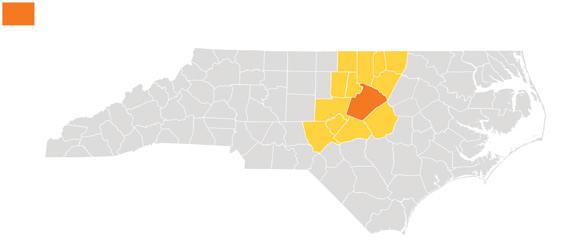
Companies across the U.S. raised about $235 billion in venture capital in 2022, with about half of that money going to companies in Boston, New York and California. In North Carolina, 246 companies raised $4.2 billion last year, according to the Council for Entrepreneurial Development. Nearly half of that went to Cary-based Epic Games, creator of the hit video game Fortnite.
e hope is that investors involved in the new program will spot other opportunities in the state.
“ ere are thousands of would-be entrepreneurs with ideas,” says Sampson. “ is is a big catalytic opportunity.” ■

72 BUSINESS NORTH CAROLINA GREEN SHOOTS Revitalizing rural N.C. PHOTO COURTESY OF NORTH CAROLINA RURAL CENTER
Rodney Sampson, right, from the North Carolina Rural Center, and Triangle investor Bill Spruill, discuss a federally-funded venture capital program.
A $50 million program aims to propel N.C. businesses led by those overlooked by traditional financiers.


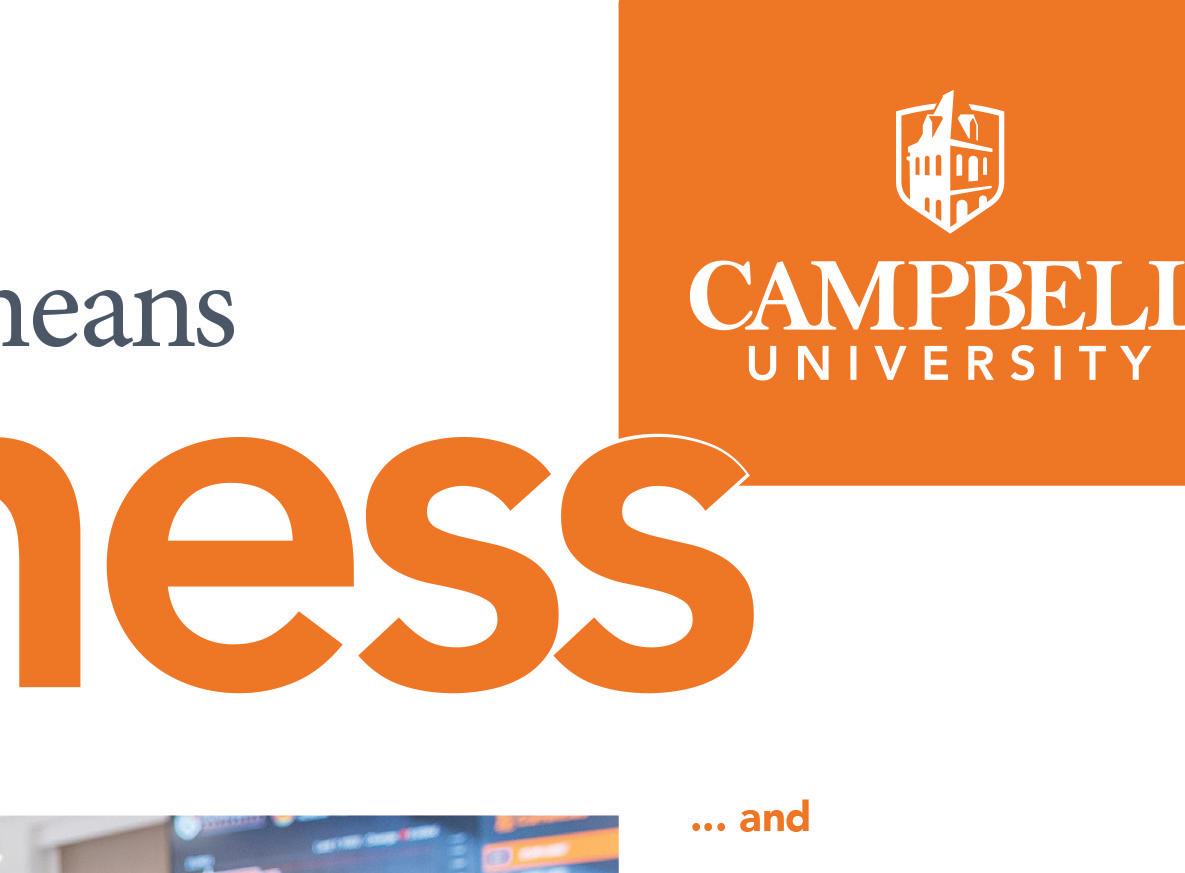


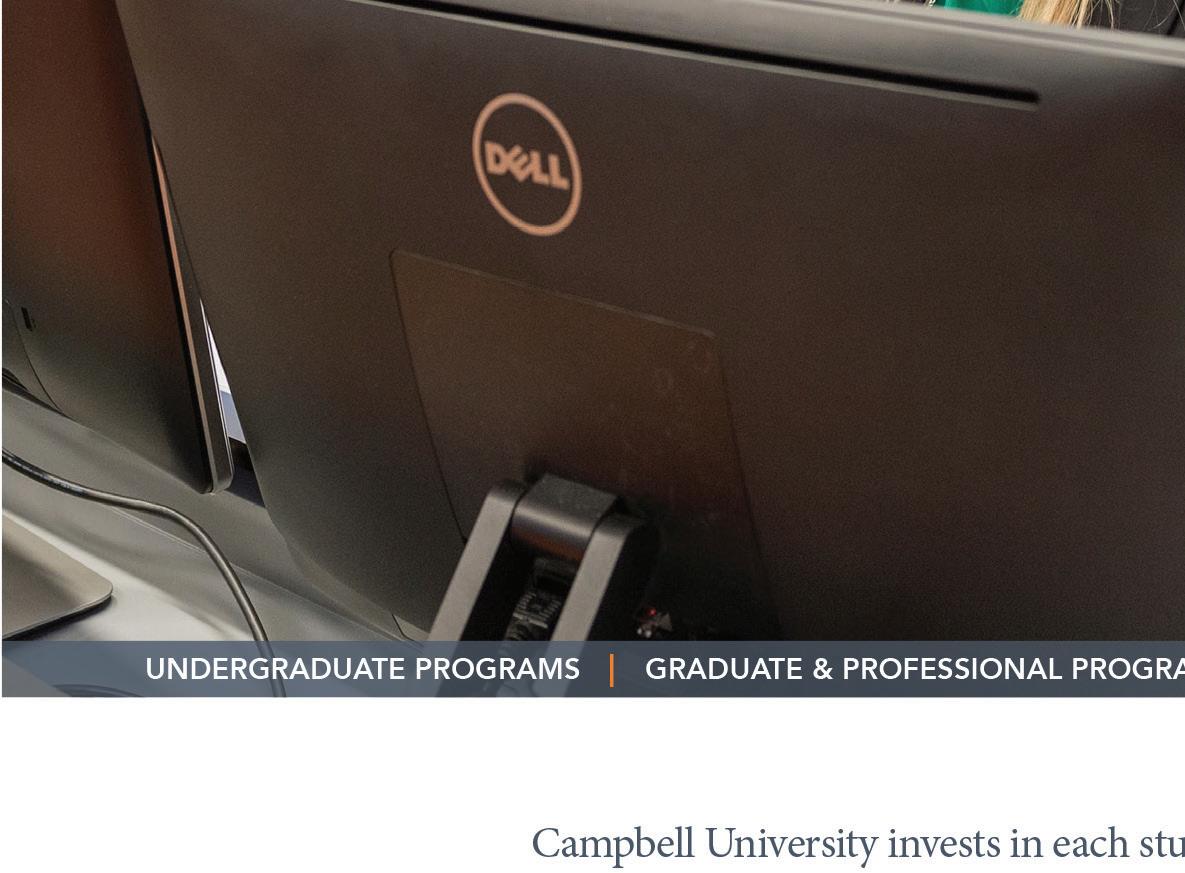































 BY EBONY MORMAN
BY EBONY MORMAN
 BY MIKE MACMILLAN
BY MIKE MACMILLAN


 BY SHANNON CUTHRELL
BY SHANNON CUTHRELL


















































































































































 By Mike MacMillan
By Mike MacMillan













































 – Brian Matthews, Union County manager
– Brian Matthews, Union County manager









 BY KEVIN ELLIS
BY KEVIN ELLIS






















